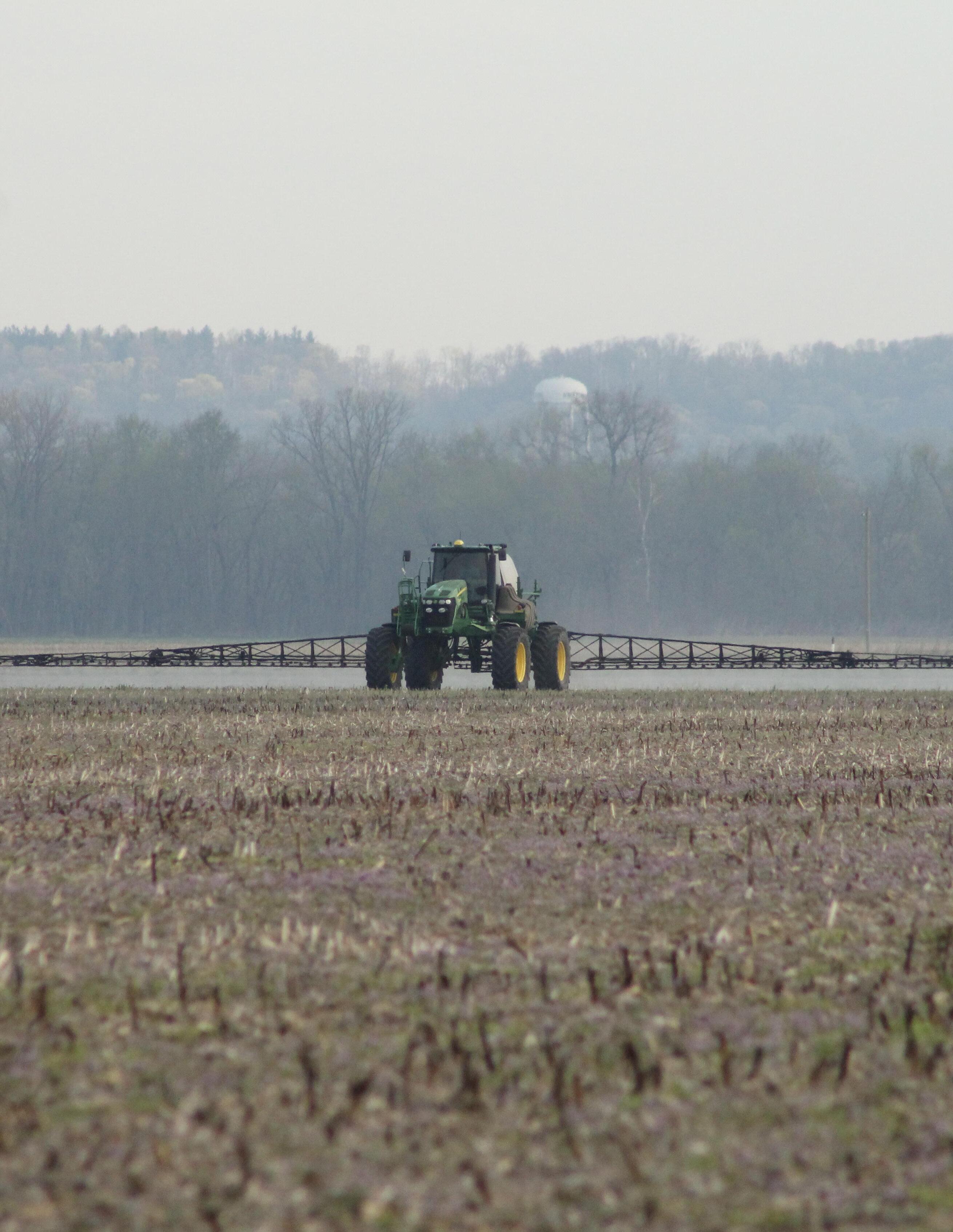

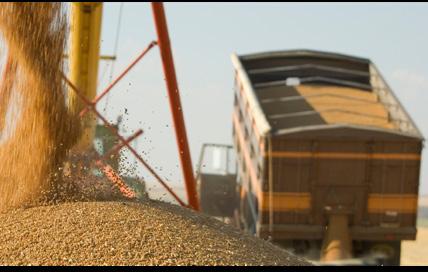




Whether due to damage or simply aging, most farm buildings eventually require repairs. Morton Buildings offers a full range of services for farmers who want to fix up or enhance their post-frame structures.
In March 2023, the USDA announced the availability of $1.05 billion through Rural Energy for America (REAP) loans and grants for energy efficiency improvements and renewable energy investments.
Renewable energy, particularly solar and wind power, is set to play a major role in the future of the U.S. electricity system. Rural communities have the potential to benefit from renewable energy projects, which can provide employment opportunities and access to electricity.
06
11
17
“CONDENSED” MILK EXPANSION MAY SUPPORT PROFITABILITY IN 2024
Change has lately been the only constant for U.S. dairy prices. The sector saw profitability decrease last year as milk prices dropped and feed prices remained elevated. Federal programs helped offset the compression in margins, but uncertainty remains as we enter 2024.
According to the USDA’s February forecast, U.S. farm incomes are projected to drop nearly 25% in 2024. This initial projection highlights the broad decline in commodity prices over the past 18 months and the corresponding impact on producer margins.
Seed, Feed and Field is a publication from AgriFinancial, dedicated to supporting American agricultural producers. This biannual resource features information on wide-ranging agricultural products raised throughout the U.S. Inside, you’ll find everything from financial tips and market data, to Farm Fresh Recipes and Farmer Features.
You will also find, as an insert and central element, The Feed by Farmer Mac, which is re-printed and included with Farmer Mac's permission as pages 17 through 34.
Slide into Spring with a new take on a old classic. Philly Cheesesteak Sliders are perfect for tear-andshare entertaining or a quick and easy dinner for the family.
37
To subscribe to Seed, Feed and Field, or to access a digital download of this publication: www.cgb-agfi.com/seed-feed-field/
For media inquiries: AgFiMarketing@cgb.com
California pistachio growers are searching the globe for potential emerging markets to handle anticipated record-shattering crops in the coming years.
38
To learn more about AgriFinancial: www.cgb-agfi.com
Toll-free 877-548-2622

The final stretch of preparations for Plant 24 is a good time to assess factors that affect production and implement new or refined practices that address weak links.During a recent presentation, Dr. Gruver highlighted incorporating a regenerative year for weed control and higher yields. 41
CGB’s grain market experts provide special reports and daily commentary on weather and market conditions that affect commodity prices and help producers manage risk. 44
Editor’s Note:
With Farmer Mac’s recent updates, making The Feed a series of regularly-published articles online, Seed, Feed and Field is undergoing some changes of it’s own. Please enjoy this condensed edition that will now be released bi-annually instead of quarterly.
As always, we strive to bring you the most up-to-date information that impacts your operation. You’ll still be able to access Seed, Feed and Field three ways; in print, as a digital download, and the online flipbook.
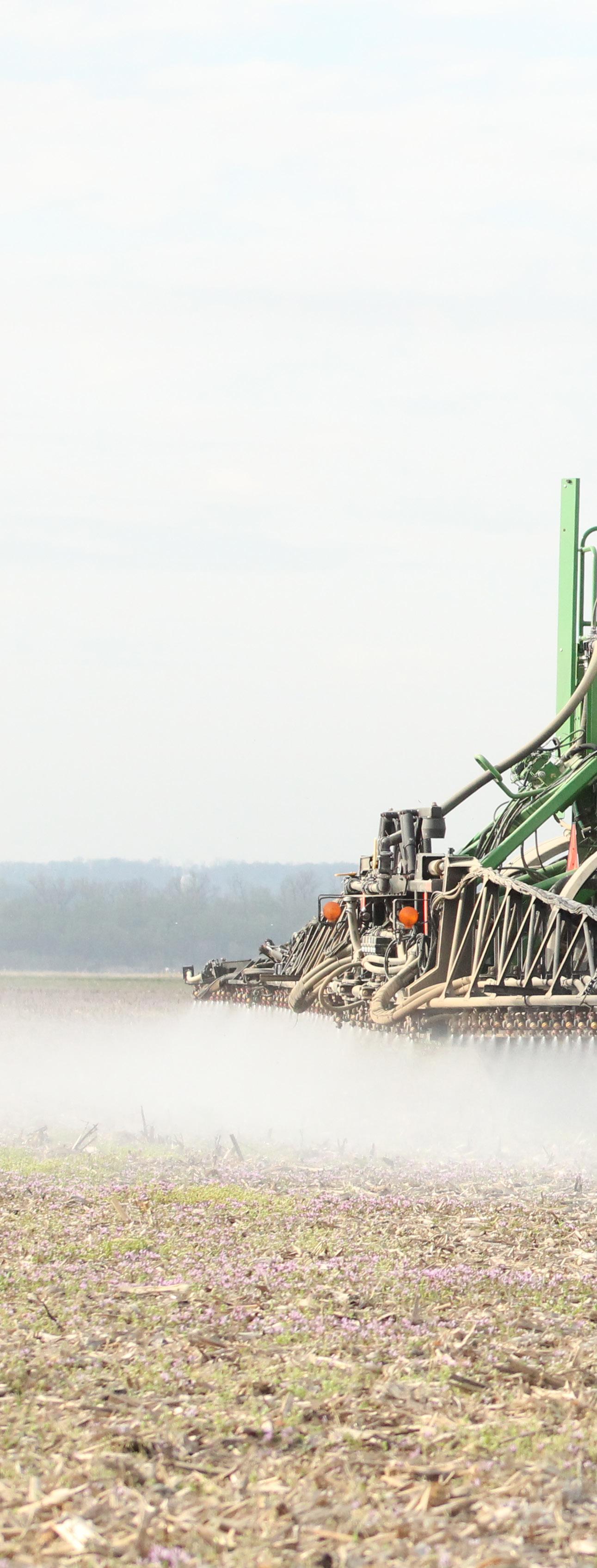
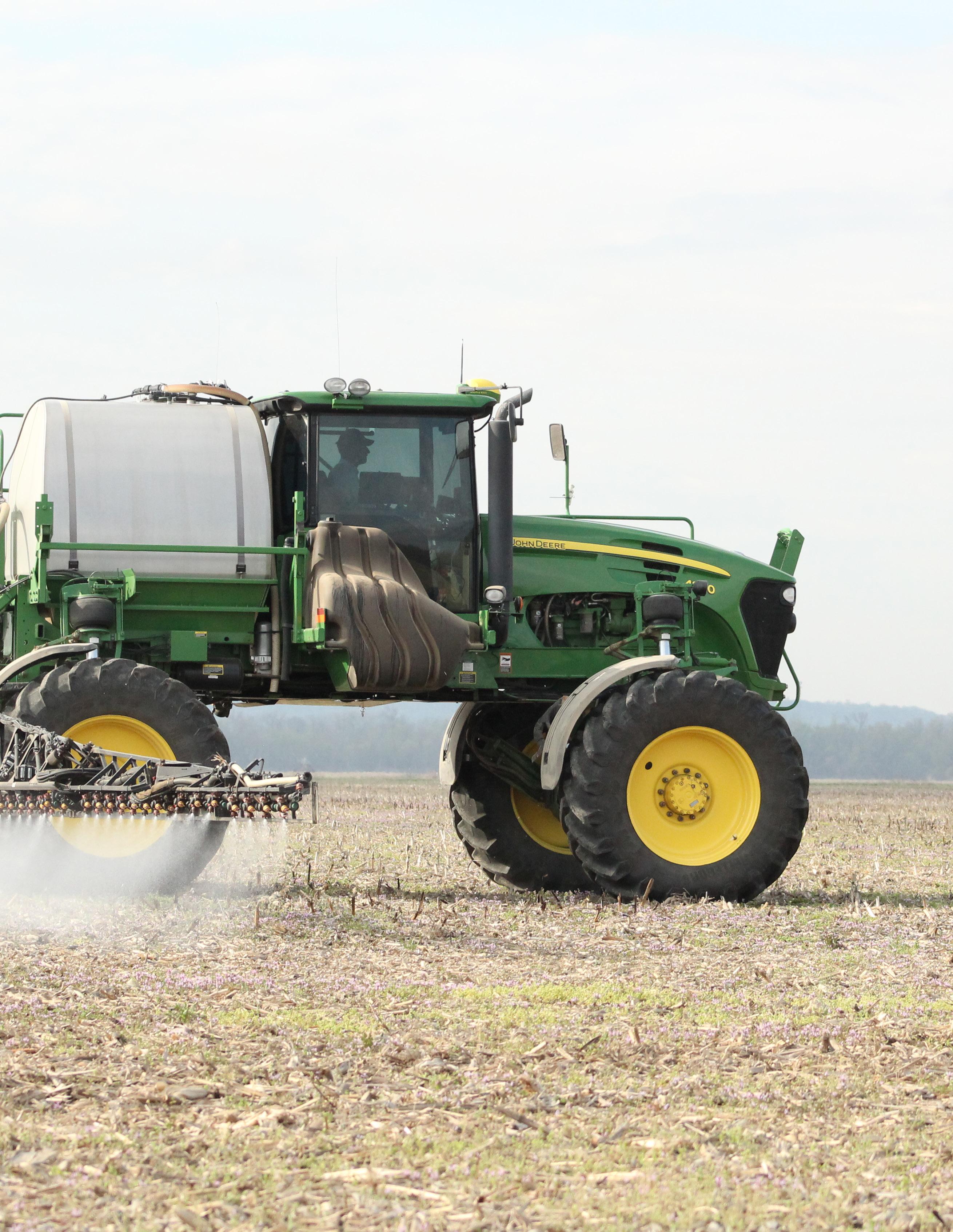

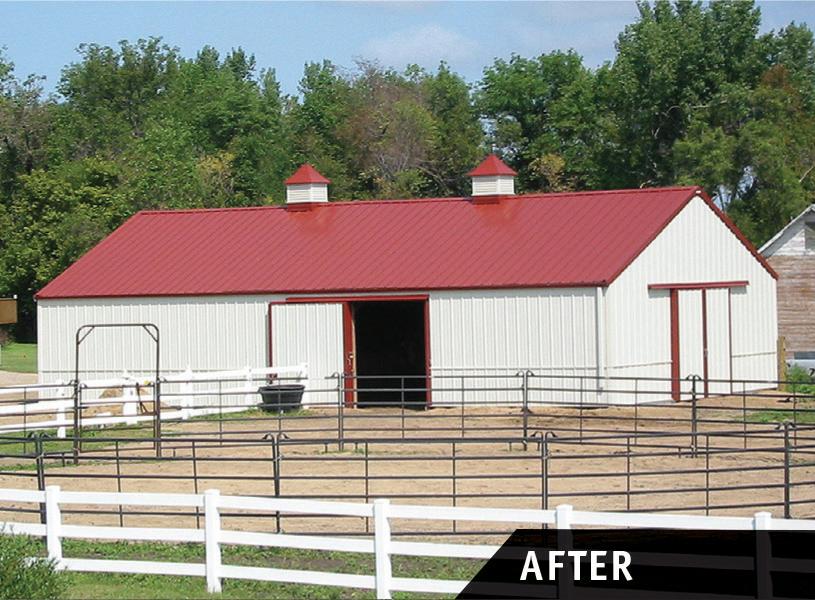



Whether due to damage or simply aging, most farm buildings eventually require repairs. Morton Buildings offers a full range of services for farmers who want to fix up or enhance their post-frame structures.
Jeremiah Fairbanks, general manager of repairs and renovations for Morton, says projects typically fall into three categories:
• An updated look — Fairbanks says the most common need is updating a building, giving it a fresh, modern look. Examples include replacing faded or rusted steel on the roof and sidewalls, installing skylights or renovating structures that otherwise might be torn down.
• Functionality — Many farmers want to add new features that enhance the performance of their buildings or make them more versatile. “Examples include a porch addition, new windows, large sliding doors, interior installation and building extensions,” Fairbanks says.
• Damage repair — He notes that well-used farm shops and garages can take a beating, whether due to storms, equipment mishaps or simple wear, which in most cases can be addressed with a variety of minor or major repairs.
Fairbanks offers several factors to consider when planning a repair or renovation:
• If repairing weather damage, be sure to talk with your insurance agent to determine what is covered. Regardless if damage has occurred, it is good practice to get a fresh property valuation obtained on a 3-year cycle to keep in line with construction costs.
• Check whether any building damage or wear is protected by warranties.
• If functionality is the issue, think about your needs — and what updates are needed to meet current as well as future requirements.
• Finally, while many farmers have the basic skills to do some of their own repairs, it’s not always easy to fix a building. “There are issues involving safety and proper installation, and some
materials may be hard to come by,” Fairbanks cautions. “Using a professional can help you avoid problems and save money in the long run.”
He adds that it can be tough to decide whether to repair or replace a farm building since many farmers become attached to older buildings that have been in the family for a long time.
“Some of these structures can be updated and preserved,” he says. “In other cases, it may be impractical to repair a building that is not structurally sound or is too small to meet needs.”
For farmers who decide on a new building, Fairbanks says to be sure to factor in not only the cost of the structure but also other associated costs, such as the concrete, foundation, and utilities. “Renovating may be a more cost-efficient way to meet your building needs until you are ready to build new.”

Fairbanks recommends that farmers ask these questions when selecting a contractor for a repair or renovation project:
• Do they have experience repairing or renovating post-frame buildings? “We’ve heard of many cases where contractors without prior experience have encountered problems with repairs or upgrades to post-frame buildings, especially relating to framing and airflow/exchange,” Fairbanks says.
• What warranty coverage is provided, especially for steel reskins and residing? “Morton’s steel warranties are for 35 years and are handled in-house, unlike the warranties offered by some builders. These pass-through warranties involve third parties, which can be challenging to reach when making a claim.”
• How long has the contractor been in business, and do they have local customers who can serve as references?
Morton Buildings provides repairs through most of their construction centers for their own postframe structures, as well as most other brands of post-frame buildings. For more information, visit mortonbuildings.com/repairs.

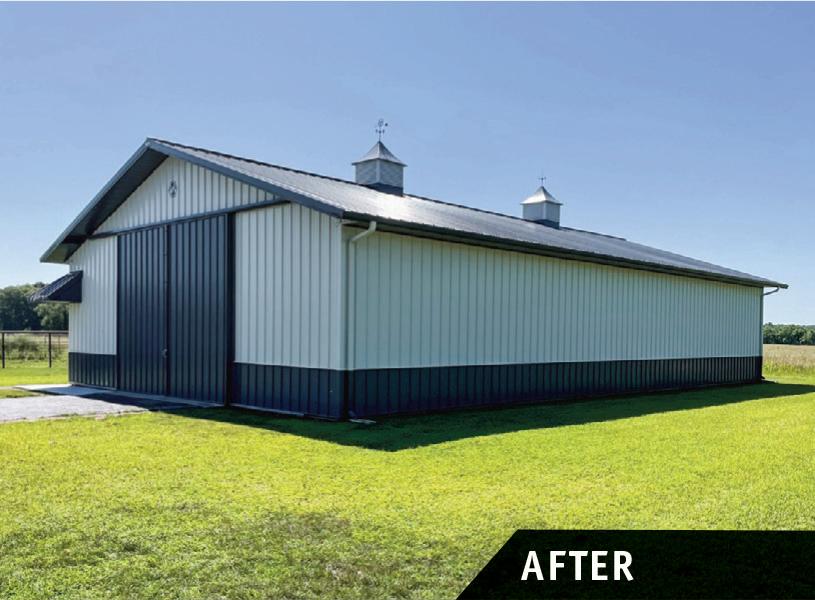
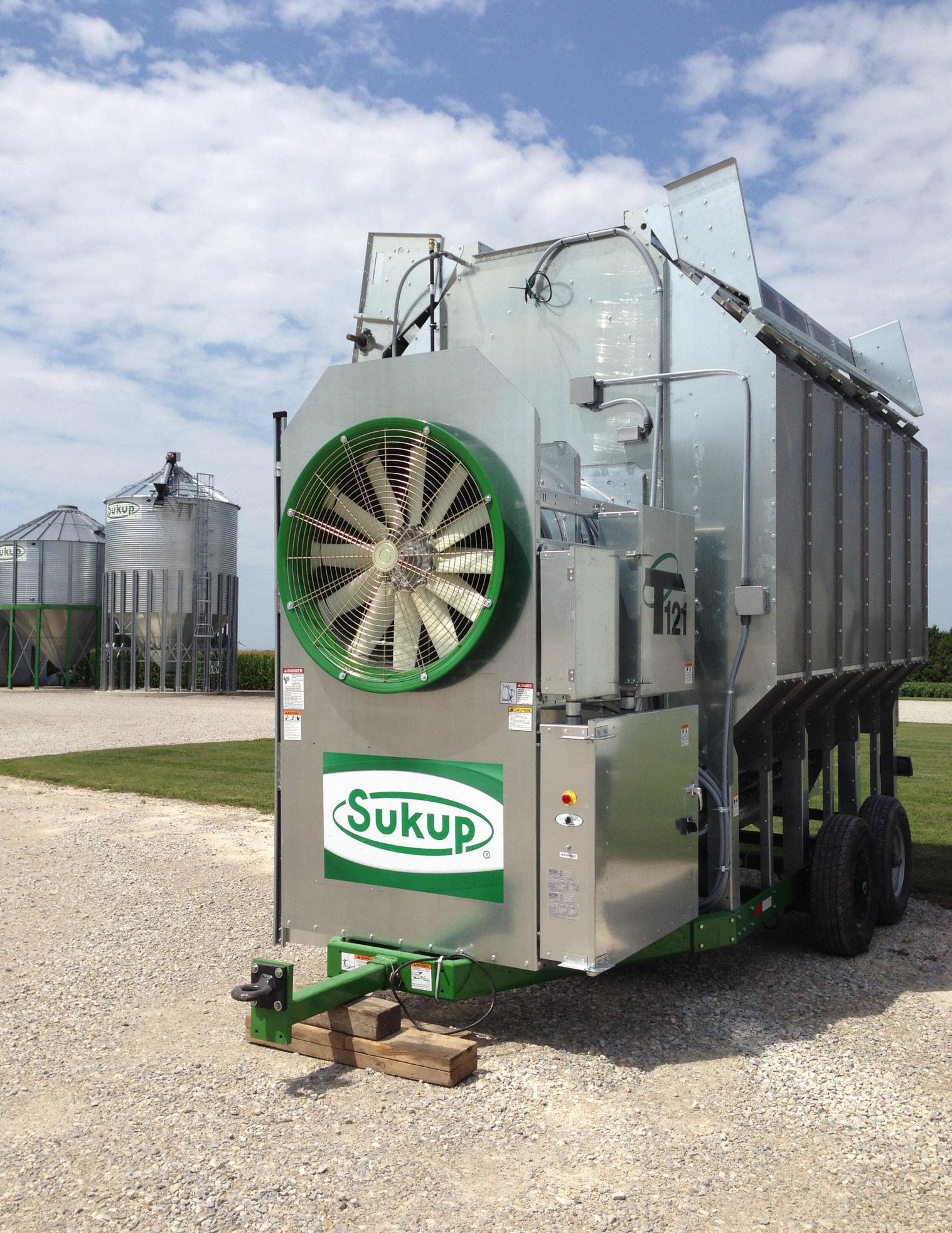

In March 2023, the USDA announced the availability of $1.05 billion through Rural Energy for America Program (REAP) loans and grants. These funds are a part of the Inflation Reduction Act and are designed to “help agricultural producers and rural small business owners make energy efficiency improvements and renewable energy investments to lower energy costs, generate new income, and strengthen the resiliency of their operations.”
There’s a lot of information available on the web and can be challenging to navigate. Here is a brief summary, in the form of an FAQ, that can help farmers better understand the program. Please note: The answers contained in this document are specific to the grant funds only. For further information on the loan funds available, please access the resources via the QR codes.
**This article is designed to be an informational and educational tool only. Information provided is not a promise or guarantee of a customer’s eligibility. AgFi does not, by virtue of this publication, render investment, legal, accounting, tax or other professional advice. We recommend that you seek the advice of an official REAP/ USDA representative before application.
There are significant eligibility requirements to take advantage of this program. The USDA has made available a Q&A document online that provides extensive details. You can access that document by scanning the QR Code at the end of this article.
Here are a few bullets to get you started.
Projects eligible for up to 50% of Total Eligible Project Costs must meet one of the following criteria:
• Renewable energy systems or retrofits that produce zero greenhouse gas emissions at the project level
• Projects located in an Energy Community (Access the map by scanning the code on pg 14)
• Energy efficiency improvement projects (as defined below)
• Projects proposed by eligible Tribal entities
All other projects remain limited to 25% or less federal grant share.
The USDA Rural Development defines an energy efficiency improvement, “as improvements to or replacement of an existing building or systems or equipment, owned by the applicant, that reduces energy consumption on an annual basis. An energy audit or energy assessment is required which shows energy savings (kwh/btu) as a result of the proposed improvements. Examples include but are not limited to lighting, refrigeration, heating, ventilation and cooling, automated controls, and insulation.”

When can you apply?
There are six quarterly application periods. The fourth of the six closes out March 31, 2024. The remaining application periods are April 1 - June 30, 2024 and July 1 – September 30, 2024.
How much $$ is available?
The maximum grant assistance for an applicant in one fiscal year is $1,500,000 ($500,000 for energy efficiency projects and $1,000,000 for renewable energy systems). *Maximum grant award applies to all affiliated entities as if they applied as one applicant.
What do I need to know if I’m installing a grain dryer?
You could receive up to 50% of the total project costs (you are responsible for the remaining 50% of the project costs) if you are upgrading an existing system. An energy audit must be conducted and show energy savings to be eligible for the grant.

The applicant must fully own and operate the project for which they are applying. Lease to own or capitalized leases can encumber ownership; however, there are options available to structure financing to meet this ownership requirement.
AgriFinancial has funded numerous projects that have qualified for REAP grants and have multiple options available for producers interested in pursuing this program.
What if I’ve already finished installation of my project or construction is in process? Can I still apply?
No. All projects require an environmental review prior to award or construction.
If I’m awarded a grant, what happens if my project costs increase during construction?
Your grant dollars are based on the amount requested at time of application. While your grant amount can be decreased if your project comes in under the approved amount, it cannot be increased.

Should your project require more funds, AgriFinancial can adjust your financing to meet your needs with quick and simple approval for eligible customers.
Contact your state coordinator to discuss your specific project, see if it’s eligible, and begin the application process. Find your state contact by scanning the QR code on the following page.

USDA Property Eligibility. (https://eligibility. sc.egov.usda.gov/eligibility/welcomeAction. do?pageAction=rbs)
Announcing $145 Million to Expand Access to Renewable Energy and Lower Energy Costs for Rural Americans: (https://www.rd.usda.gov/inflationreduction-act/rural-energy-america-program-reap)
Federal Register: Notice of Solicitation of Applications for the Rural Energy for America Program for Fiscal Years 2023 and 2024, Correction. (https://www.federalregister.gov/ documents/2023/05/31/2023-11435/notice-ofsolicitation-of-applications-for-the-rural-energy-foramerica-program-for-fiscal-yearsrrection)
Rural Energy for America Program: Inflation Reduction Act Changes. (https://www.rd.usda.gov/ media/file/download/reap-ira-changes.pdf 2 (usda. gov))
Rural Energy for America Program Renewable Energy Systems and Energy Efficiency Improvements Questions and Answers. (https://www.rd.usda.gov/ media/file/download/reap-renewable-energysystems-faqs.pdf)
Rural Business-Cooperative Service State Energy Coordinators. (https://www.rd.usda.gov/sites/ default/files/RBS_StateEnergyCoordinators.pdf)
Rural Energy for America Program Renewable Energy Systems & Energy Efficiency Improvement Guaranteed Loans & Grants. (https://www.rd.usda. gov/programs-services/energy-programs/ruralenergy-america-program-renewable-energysystems-energy-efficiency-improvement-guaranteedloans)






Renewable energy, particularly solar and wind power, is set to play a major role in the future of the U.S. electricity system. While it offers environmental, economic, and social benefits, it also requires investments in infrastructure, smart grid technologies, and regulatory frameworks. Rural communities have the potential to benefit from renewable energy projects, which can provide employment opportunities and access to electricity.

The pace of renewable power generation and storage growth has surged in recent years. According to the International Energy Agency, renewables are set to account for 95% of the net increase in global power capacity through 2025, surpassing natural gas and coal to become the largest source of worldwide electricity generation. In the U.S., renewable energy generation is expected
to increase in the next few years, driven by favorable policies, technological innovations, and cost reductions.
One of the fastest-growing renewable energy sources in the U.S. is solar power, which has seen remarkable growth in recent years. According to the U.S. Energy Information Administration (EIA), solar photovoltaic (PV) capacity increased
forecasts that solar PV will account for more than 65% of all renewable capacity additions through 2025, reaching 172 GW by the end of that year. According to EIA estimates, solar PV alone could provide nearly 14% of the total U.S. electricity capacity in 2025, up from 8% in 2023.
Another important renewable energy source in the U.S. is wind power, which has experienced significant growth in recent years. According to the EIA, U.S. wind capacity increased 6% in 2023 to 149 GW. The EIA projects that wind will account for 30% of all renewable capacity additions through 2025, reaching 162 GW by the end of that year. Wind alone could provide an estimated 13% of the total U.S. electricity capacity in 2025.
The graph below highlights the current expectations of additions and retirements to U.S. electricity capacity in the coming years. Additions tend to be concentrated in the next two years, while retirements are more balanced based on the age and technology of the generating assets. More additions will likely be announced in future years, which could balance out future additions and retirements. Bloomberg New Energy Finance projections show a steady increase in renewable capacity additions through 2035 before slowing down. EIA data on planned additions includes only announced renewable projects.
One of the advantages of renewable energy is that it can bring economic opportunities
Planned additions and retirements to U.S. electricity production between 2024 and 2028 (as of 11/30/2023)
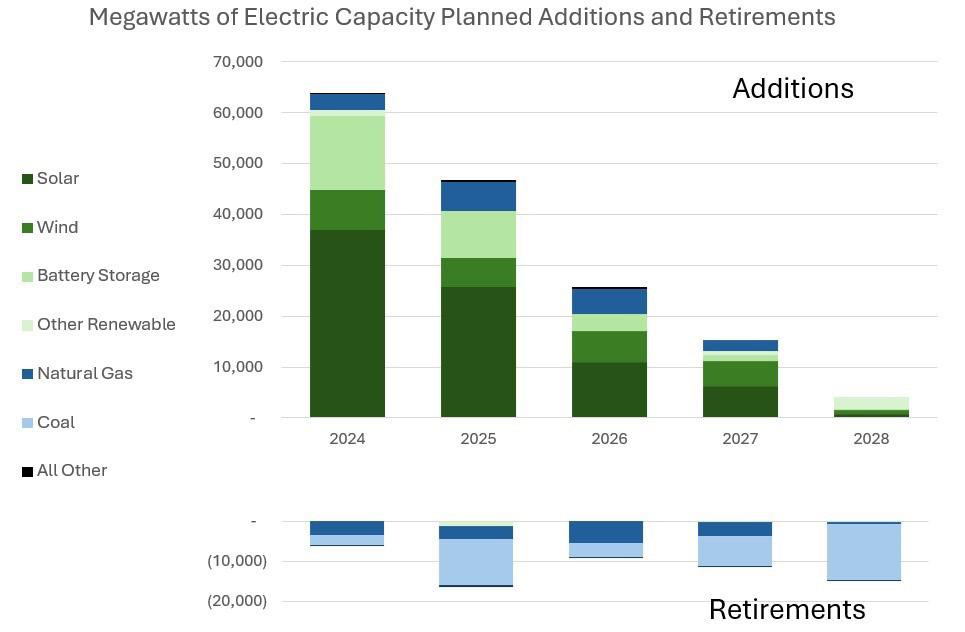
and benefits to rural areas, where many of the solar and wind projects are located. According to a report by the International Energy Agency, renewable energy projects can provide income, employment, and social services for rural communities and improve access to electricity. Texas and California have the most capacity planned and announced by the EIA between 2024 and 2028, with over 65 gigawatts of generation capacity planned and over 90% of that capacity to come from renewable power sources.
However, the growth of renewable energy also faces challenges in grid integration, storage, and transmission. To ensure a reliable and resilient electricity system, renewable energy sources must be integrated with conventional power plants, energy storage systems, and transmission networks. This requires investments in infrastructure, smart grid technologies, and regulatory frameworks. The EIA estimates that the U.S. will need to add 42 GW of battery storage capacity by 2025, an increase of 89% from 2023, to support the growth of solar and wind power. There are already more than 13 GW of battery storage projects planned for 2024 and 2025, primarily in California and Texas, where the most solar PV projects are also planned. The EIA also expects that


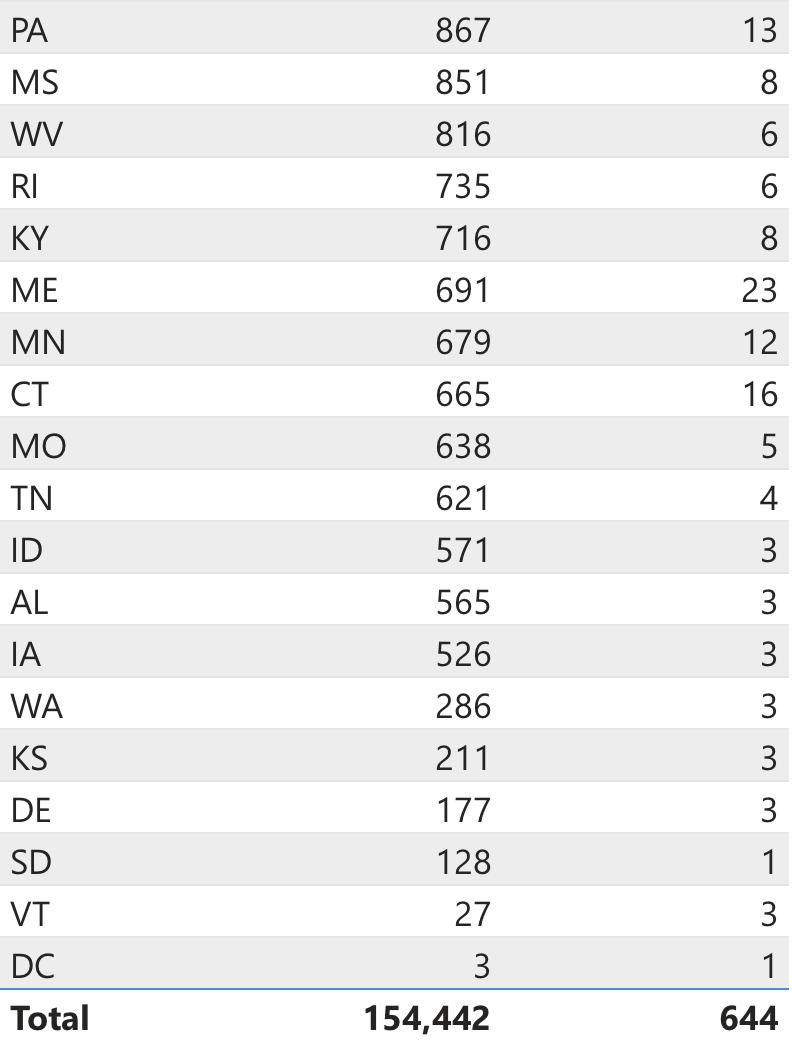

Source: U.S. Energy Information Administration, Prelimary Monthly Electric Generator Inventory, November 2023 Excludes Alaska and Hawaii
the U.S. will need to expand its transmission capacity by 7% by 2025, mainly to connect renewable energy projects in rural areas to load centers in urban areas.
In conclusion, renewable energy is set to play a big part in the future of the U.S. electricity system, as it offers potential economic, environmental, and social benefits. Investment is heavily focused in rural and ex-urban areas. However, the implementation of renewable energy also requires careful planning, coordination, and innovation to overcome the technical and institutional barriers. The U.S. has the potential and the opportunity to be a leader in the global energy transition. Rural America is poised to be central in the investment in future energy production.


Interact with the graphs and charts in this article by accessing it online.
EIA Planned Capacity (2024 - 2028) Based on November 2023 Preliminary Monthly Electric Generator Inventory
Change has lately been the only constant for U.S. dairy prices. The sector saw profitability decrease last year as milk prices dropped and feed prices remained elevated. Federal programs helped offset the compression in margins, but uncertainty remains as we enter 2024. A rebound in exports coupled with stable dairy inventories could provide modest support for prices and margins.
As the calendar flips to 2024, U.S. dairy producers face numerous mixed signals up and down the dairy supply chain. On the one hand, domestic demand remains robust, buoyed by an insatiable U.S. appetite for cheese, yogurt, and other dairy goods. On the other hand, export demand has softened as economic woes have emerged in a few key dairy import markets. Combined, these competing factors have led to elevated uncertainty in the sector.
If viewed through a microscope, the trend in 2023 milk prices might indicate financial stress for dairy producers. Indeed, the rapid price drop last year, combined with elevated feed costs, triggered significant Dairy Margin Coverage (DMC) payments to producers. DMC payments topped $1.2 billion through November 2023, peaking in mid-2023. In June 2023, the milk-to-feed price ratio dropped to 1.36, its lowest level since the mid-1980s save for a blip in 2012. Fortunately, the ratio has since reversed, rising above 2.0 in December as feed
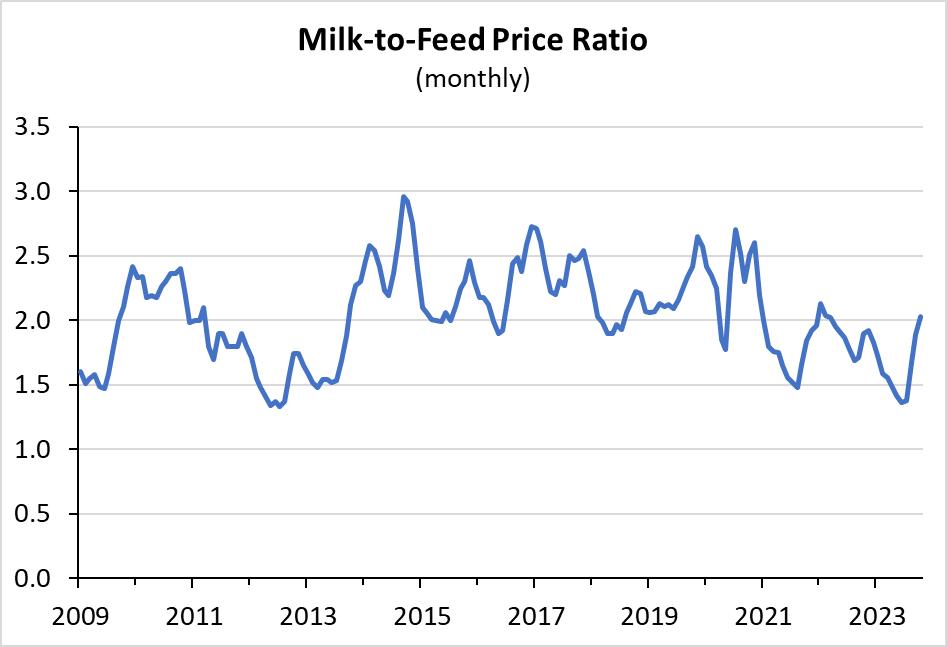
Source: Author’s Calculations
costs declined and milk prices rose. Still, the ratio remains below its 20-year average of 2.26, underscoring the compression in dairy sector profitability over the last year.
During the last few years, one of the only constants for U.S. dairy prices has been change. Class III milk prices bounced higher and lower in response to the COVID-19 pandemic and subsequent government programs aimed at boosting dairy demand. When those effects wore off, strong export demand, rising feed costs, and a contraction of the U.S. beef cattle herd helped push prices to record levels in 2022. Class III milk prices peaked above $25 per
hundredweight in 2022 before dropping rapidly in 2023, declining by as much as 50%. At this time, prices remain volatile but have since recovered from the lows experienced last year, much to the relief of producers.
Looking ahead, market data suggest milk prices could stabilize this year, potentially at marginally higher levels. As of early January, the average Class III futures market price for the year was $17.59, above the $17.09 average for 2023. The USDA’s projection in the January WASDE was less optimistic, but still showed Class III prices averaging $16.10 in 2024. There is certainly reason for optimism, given the limited expansion in the sector over the past two years and the broad decline in feed prices. However, higher labor costs and declining export volumes also portend a headwind.
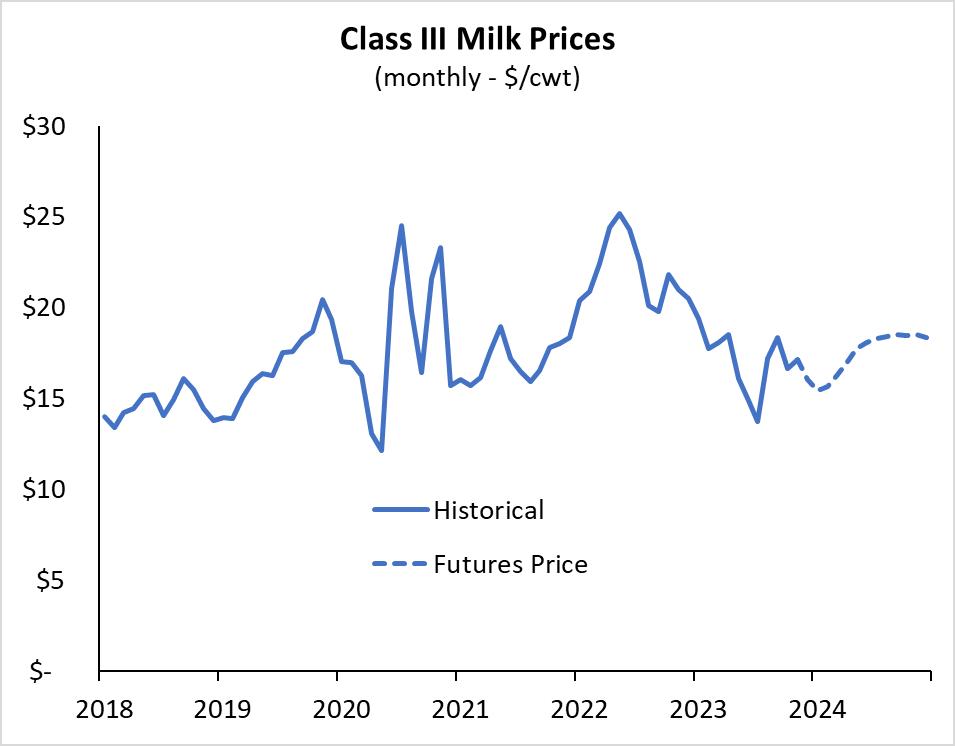
One of the notable contributors to declining dairy prices last year was reduced export demand. Export volumes of U.S. dairy products dropped 6% in 2023, partly due to weaker Chinese import demand for whey and cheese. Through October, dairy exports were $1.3 billion lower in 2023 than at the same time in 2022, including $140 million less to China. Acknowledging last year’s slowdown, the USDA currently projects U.S. dairy
export volumes will bounce higher in 2024. Its current forecast shows export volumes rising nearly 7% in 2024. It is important to note that the total value of U.S. dairy exports could still decline this year if the unit value prices are low enough. However, substantial export volumes would help limit a buildup in domestic inventories. Indeed, the USDA currently projects U.S. dairy inventories will decline 5% over the next 12 months. Higher exports and stable domestic inventories could provide support for prices.
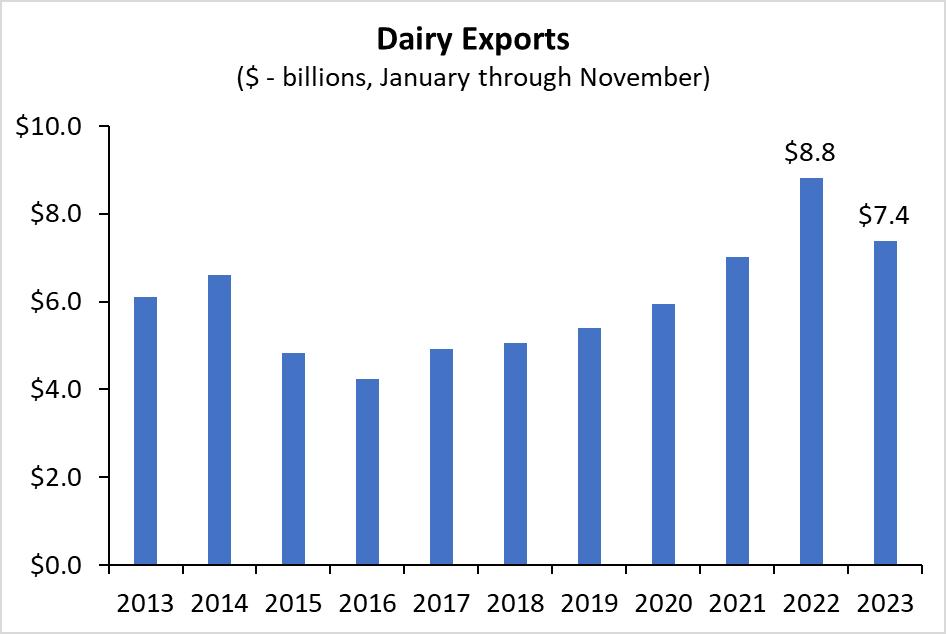
Fortunately for U.S. producers, tepid export demand has been partially offset by limited expansion in the sector. After increasing a meager 0.1% in 2022, the USDA projects milk production grew by only 0.2% in 2023. The growth rate in both years was well below the average of 1.3% annual growth from 1970 to 2021. Dairy producers have been relatively restrained in increasing production due to elevated feed costs, challenges in sourcing labor, and greater financing costs associated with building new barns. Many of these challenges are unlikely to be resolved in the near term. As a result, the USDA projects a modest 0.9% growth in U.S. milk production in 2024.
One benefit from slow dairy production growth has been a limited buildup in U.S. dairy inventories. Butter inventories at the end of November were 8% higher than last year, while cheese inventories were unchanged. Cheese inventories are nearly seven times larger than butter inventories, though, so total inventories increased a relatively modest amount. U.S. dairy stocks in cold storage have stayed relatively stable despite the export slowdown.
The challenge in determining where dairy sector profitability may head in 2024 stems from Conclusion

Source: Author’s Calculations
competing headwinds and tailwinds. Feed costs have declined recently due to the recovery in global annual crop inventories. However, feed prices remain elevated and could bounce higher in 2024 if a dry winter causes hay prices to spike. On the demand front, exports were hindered last year by a tepid global economy and a strong U.S. dollar. This year exports are projected to increase, which should support prices. Ultimately, the limited expansion of U.S. dairy production over the last two years could be a silver lining that supports dairy sector profitability in 2024, if only at modest levels.
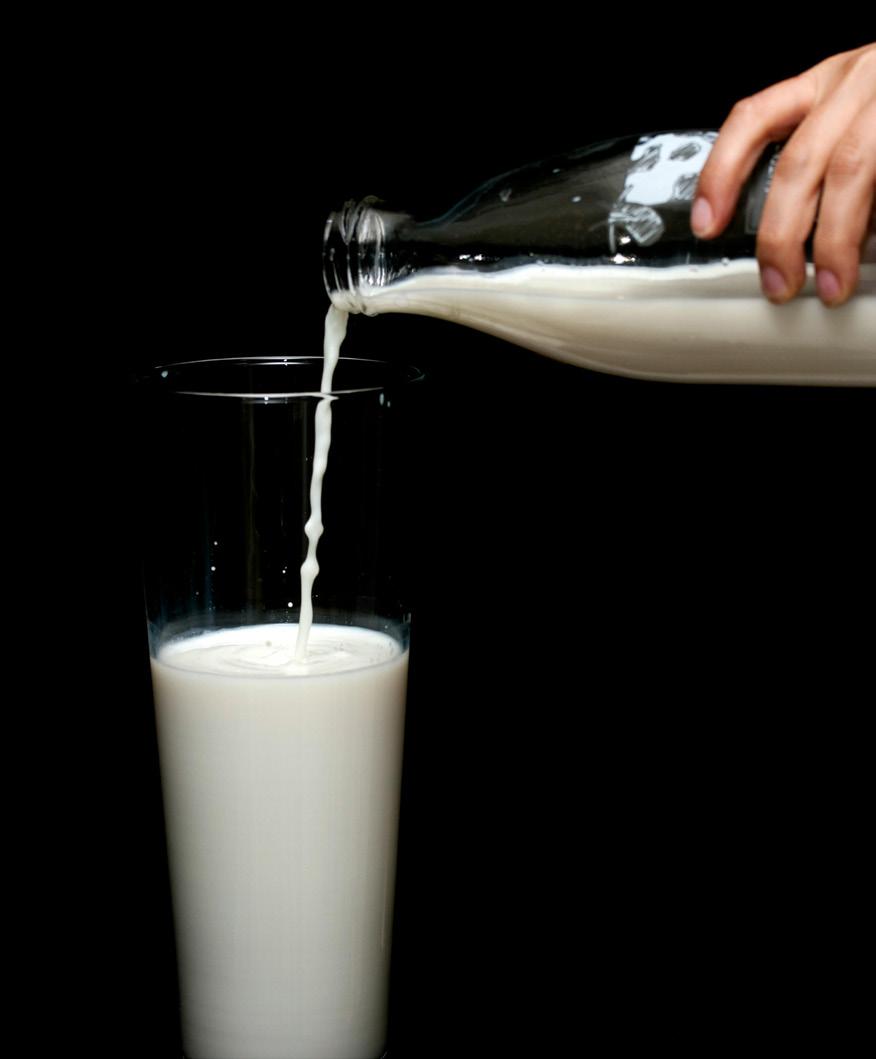

According to the USDA’s February forecast, U.S. farm incomes are projected to drop nearly 25% in 2024. This initial projection highlights the broad decline in commodity prices over the past 18 months and the corresponding impact on producer margins. Still, the February forecast tends to undershoot the realized farm income value for the year.

The USDA provided its initial forecast for 2024 farm incomes in early February, projecting that sector margins will decline for the second year. Net cash farm income (NCFI) is forecast to drop to $122 billion in 2024, a decline of 24% from last year and 40% lower
than the record level reached in 2022. This largely reflects the broad decline in agricultural commodity prices over the past 18 months. However, it’s worth highlighting that the projected decline may not fully encapsulate the farm income story for 2024.
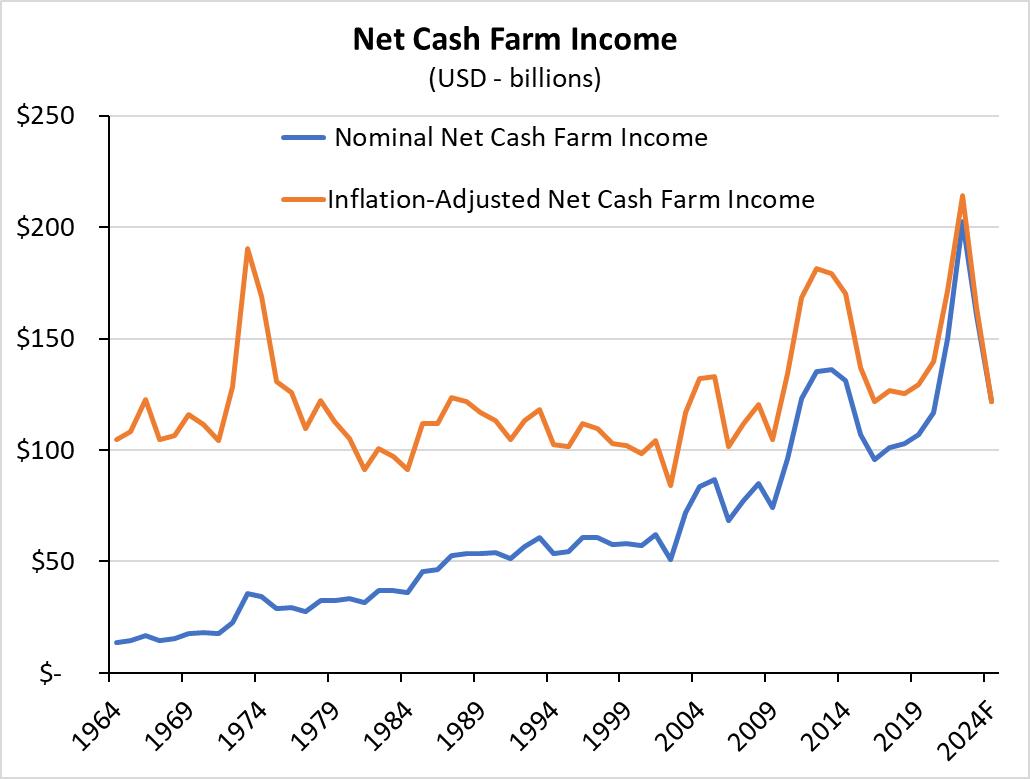
A key factor in declining NCFI has been lower commodity prices. For example, corn and soybean futures prices are approximately 47% and 32% lower, respectively, than their 2022 peaks. The decline in commodity prices has been broad, with wheat, cotton, and other major commodities also seeing a pullback. As a result, agricultural revenues are projected to drop 4% in 2024 after declining 5% last year. The last time NCFI dropped two consecutive years was between 2018 and 2020. The decline then was at much lower levels, though, and due partially to COVID-19-related impacts.
Another contributor to the decline in farm revenues is the continued pullback in government payments. Government payments to farmers are forecast to be $10 billion in 2024, down 16% relative to last year. Government payments to farmers totaled as much as $71 billion in agricultural revenue between 2020 and 2021, largely attributable to programs intended to offset the impact of COVID-19-related disruptions. Farm profitability changed significantly, though, and payments are now forecast to remain below the long-term average this year. Even within the expected $10 billion in government payments this year, over 40% are related to conservation programs, which occur regardless of the ag economic landscape. One potential silver lining to lower government payments is that it may help alleviate concerns from some lawmakers about
recent elevated government support for the farm economy as Congress looks to pass a new Farm Bill.
Acknowledging the broad pullback in revenues, agricultural sector revenues are still forecast to remain elevated in 2024 relative to historical averages. The projection for $485 billion in sector revenue would be in the top twentieth percentile for revenues after adjusting for inflation. Prices for many agricultural commodities have trended lower over the previous two years after reaching historical highs. However, overall price levels remain higher than historical averages, and the elevated revenues may help offset the impact of rising expenses.
Perhaps the most interesting component of declining NCFI, though, was the projected
increase in farm expenses, as they typically move in parallel. Total cash expenses are forecast to increase by nearly 4% in 2024. While not an exorbitant increase, it becomes noteworthy when examining individual components. Feed costs, for example, are forecast to increase by 1% this year compared to last year. This runs counter to the broad decline in corn, soybean, and wheat prices. Furthermore, the national average hay price continues to trend lower, and in December, it was 24% below the April 2023 peak. Fertilizer costs are also forecast to increase by 4% in 2024, despite entering the year approximately 18% lower than last January 2023.
While not guaranteed, the USDA’s February farm income forecast tends to be conservative relative to the eventual value. There is a chance that future estimates of 2024 farm incomes will show lower expenses than the February forecast, which could boost the overall NCFI value.
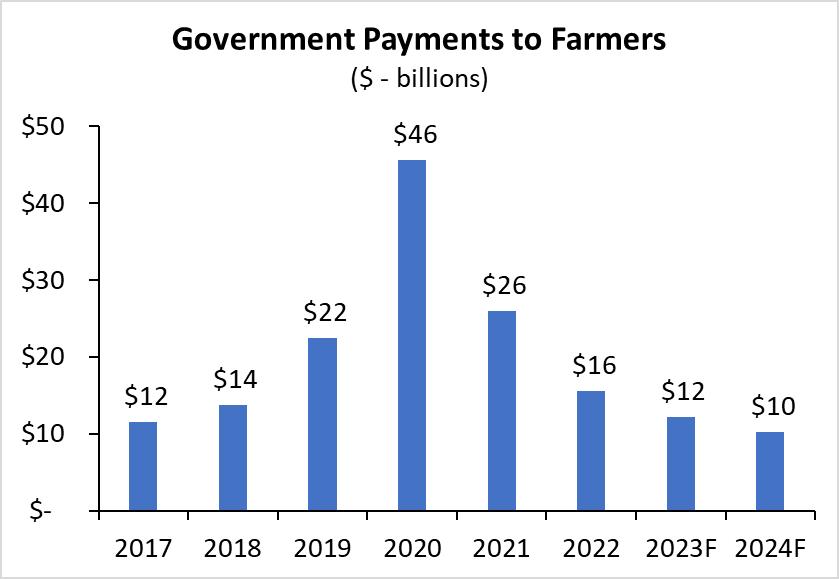
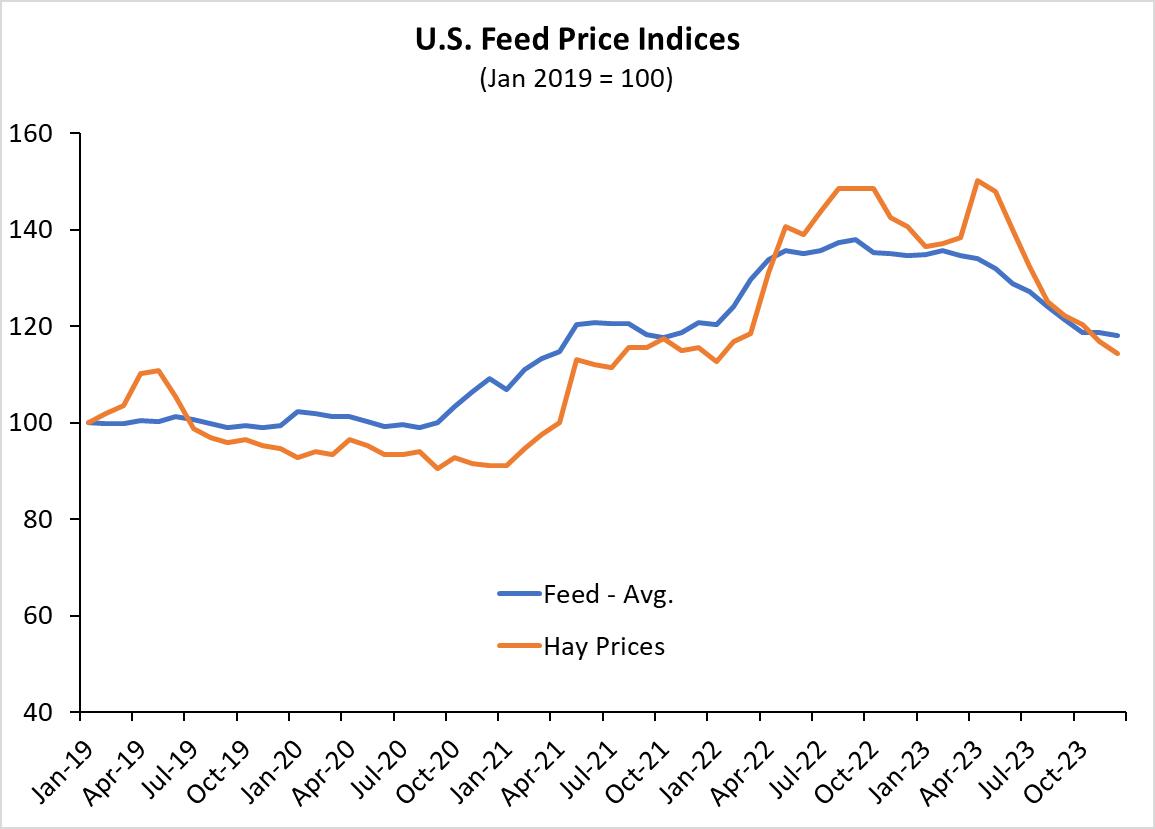
The outlook for lower farm incomes in 2024 does not apply uniformly to all producers. While many producers could see significantly tighter margins, others may benefit from stronger prices or lower costs. Hog and poultry producer revenues, for example, are forecast to increase by 1% and 2%, respectively, in 2024. While not record-breaking, higher revenues should help both sectors after being buffeted by high feed costs and challenging margins in 2023. Fruit and tree nut revenues are also forecast to increase by 3% this year. Almond and walnut prices have been relatively weak in recent years due to tepid export demand.
However, export demand has increased over the past six months and helped lift prices for both commodities.
Those involved in the agricultural sector are no strangers to cycles. Just as rising commodity prices fueled a surge in farm incomes in the past few years, a rapid turnaround in global agricultural inventories is now putting downward pressure on farm incomes today. At face value, the USDA’s February forecast shows a relatively large decline this year. However, context is needed and the USDA is likely to revise from this initial projection in future updates.




Jackson Takach, Chief Economist, is a Kentucky native whose strong ties to agriculture began while growing up in the small farming town of Scottsville. He has since dedicated a career to agricultural finance where he can combine his passion for rural America with his natural curiosity of the world and his strong (and perhaps unrealistic) desire to explain how we interact within it. He joined the Farmer Mac team in 2005, and has worked in the research, credit, and underwriting departments. Today, his focus at Farmer Mac currently includes quantitative analysis of credit, interest rate, and other marketbased risks, as well as monitoring conditions of the agricultural economy, operational information systems analysis, and statistical programming. He holds a Bachelor’s degree in economics from Centre College, a Master’s degree in agricultural economics from Purdue University, and a Master’s of Business Administration from Indiana University’s Kelley School of Business.
Blaine Nelson is the Senior Economist on the Strategy, Research, and Analytics team at Farmer Mac. In his role, he analyzes trends within America’s agricultural sector, with areas of focus including farmland values, commodity prices, interest rates, and agricultural sector profitability. He disseminates this information to borrowers and lenders to help keep them well-informed about the environment they operate in and to help guide their decisions. Blaine was raised on a commercial row crop and dairy farm in northern Minnesota and went on to earn a bachelor’s degree in Applied Economics from the University of Minnesota and a master’s degree in Agricultural and Applied Economics from the University of Illinois at Urbana-Champaign.
As Executive Vice President – Chief Business Officer, Zack leads the vision, development, and go-to-market strategy of the Farmer Mac brand. He also oversees the company’s Agribusiness activities, including the business development and marketing efforts for its foundational lines of business that provide agricultural lenders across the country with financial solutions and effective risk mitigation tools that allow farmers, ranchers, and agribusinesses access to flexible and affordable credit. In this role, he oversees the company’s expansive loan portfolio, partner and business development strategies, product innovation and standardization, and marketing and corporate communications.
Brian Brinch is Farmer Mac’s Senior Vice President – Enterprise Risk Officer and is responsible for the maintenance and continuous evolution of an enterprise-wide risk management framework that supports the strategic goals of the organization. He works closely with senior leaders across the organization and with the Board Risk Committee to build upon Farmer Mac’s existing strong and conservative culture of risk management, and helps set the vision and strategy for enterprise-wide risk management. Brian joined Farmer Mac in 2000, and most recently served as Senior Vice President of Rural Infrastructure, where he was responsible for the division’s business development and customer success strategy. Prior to that, he served as Vice President of Financial Planning and Analysis, where he led the development of the company’s strategic planning initiative and guided its financial projections and data analytics.
The Feed is Farmer Mac’s economic outlook for current events and market conditions within agriculture.
Articles cover multiple regions and commodities and incorporate data and analysis from numerous sources to present a mosaic of the leading industry information, with a focus on the latest information from the United States Department of Agriculture and their Economic Research Service.
The authors rotate through topics such as weather and major industry segments as well as other industries and topics as they become relevant in the seasonal agricultural cycle. Readers can gain insight from our unique synthesis of these multiple sources via articles published online at www.FarmerMac.com/TheFeed.
We hope you’ve enjoyed this issue.
For business inquiries:
PatrickKerrigan
Vice
President– Business Development pkerrigan@farmermac.com
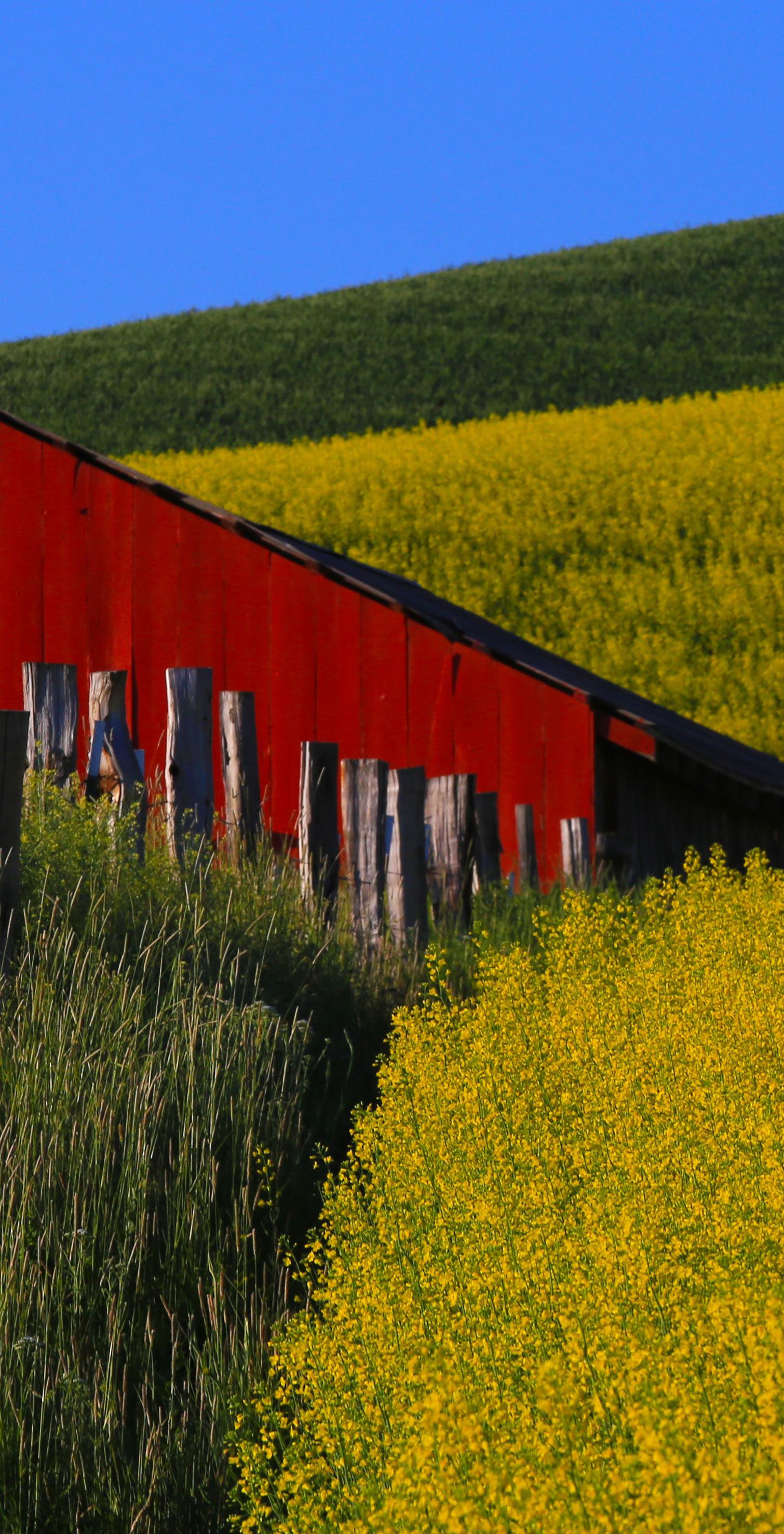

The information and opinions or conclusions contained herein have been compiled or arrived at from the following sources and references:
International Energy Agency, Electricity Market Report, 2023. (https://www.iea.org/reports/electricity-market-report-2023)
U.S. Energy Information Administration, Short-term Energy Outlook, January 2024. (https://www.eia.gov/outlooks/ steo/))
International Energy Agency, Renewables 2020. (https:// www.iea.org/reports/renewables-2020?mode=overview)
U.S. Energy Information Administration, Preliminary Monthly Electricity Generator Inventory, November 2023. (https://www.eia.gov/electricity/data/eia860m/)
Feed Grains Custom Query, USDA Economic Research Service. (https://data.ers.usda.gov/FEED-GRAINS)
World Agricultural Supply and Demand Estimates, USDA, December 8, 2023. (https://www.usda.gov/oce/ commodity/wasde/wasde1223.pdf )
Global Agricultural Trade System, USDA Foreign Agricultural Service. (https://apps.fas.usda.gov/gats/default.aspx)
Livestock, Dairy, and Poultry Outlook, USDA Economic Research Service. (https://www.ers.usda.gov/topics/animalproducts/dairy/market-outlook/)
Dairy Margin Coverage Program, USDA Farm Service Agency. (https://www.fsa.usda.gov/programs-and-services/dairymargin-coverage-program/index)
Quick Stats, USDA National Agricultural Statistics Service. (https://quickstats.nass.usda.gov/)
Class III Milk Futures, CME Group. (https://www.cmegroup. com/markets/agriculture/dairy/class-iii-milk.html)
2024 Farm Sector Income Forecast. (https://www.ers.usda. gov/topics/farm-economy/farm-sector-income-finances/farm-sectorincome-forecast/)
Green Markets Weekly North American Fertilizer Price Index. (https://fertilizerpricing.com/priceindex/)
USDA Foreign Agricultural Service Global Agricultural Trade System. (https://apps.fas.usda.gov/gats/default.aspx)
CME Group Ag Futures and Options. (https://www.cmegroup. com/markets/agriculture.html)
Understanding the Downward Bias in USDA’s Farm Income Forecasts. (https://ag.purdue.edu/commercialag/home/ paer-article/understanding-the-downward-bias-in-usdas-farmincome-forecasts/)
Evaluating the USDA’s Net Farm Income Forecast. (https://www.jstor.org/stable/26797531)
The USDA’s First Forecast For 2022 Projects Strong Incomes. (https://www.farmermac.com/wp-content/uploads/TheFeed-Spring-2022.pdf)
1999 K
Phone: 800.879.3276
www.farmermac.com/thefeed

Opinions, forecasts, estimates, projections and other views in this report constitute the current judgment of the author as of the date of this report, do not necessarily reflect the opinions of Farmer Mac or its management, and should not be construed as indicating Farmer Mac’s business prospects or expected results. The information contained in this report has been compiled from what Farmer Mac regards as reliable sources. Farmer Mac does not guarantee that the information provided in these materials is accurate, current or suitable for any particular purpose and Farmer Mac disclaims any responsibility for the information, third-party opinions, and data included in this report. Farmer Mac has no obligations to update, modify, or amend this report or to otherwise notify a recipient thereof if any opinion, forecast, or estimate contained herein changes or subsequently becomes inaccurate. Information from this report may be used with proper attribution. Alteration of this report or its content is strictly prohibited. ©2024 by Farmer Mac.


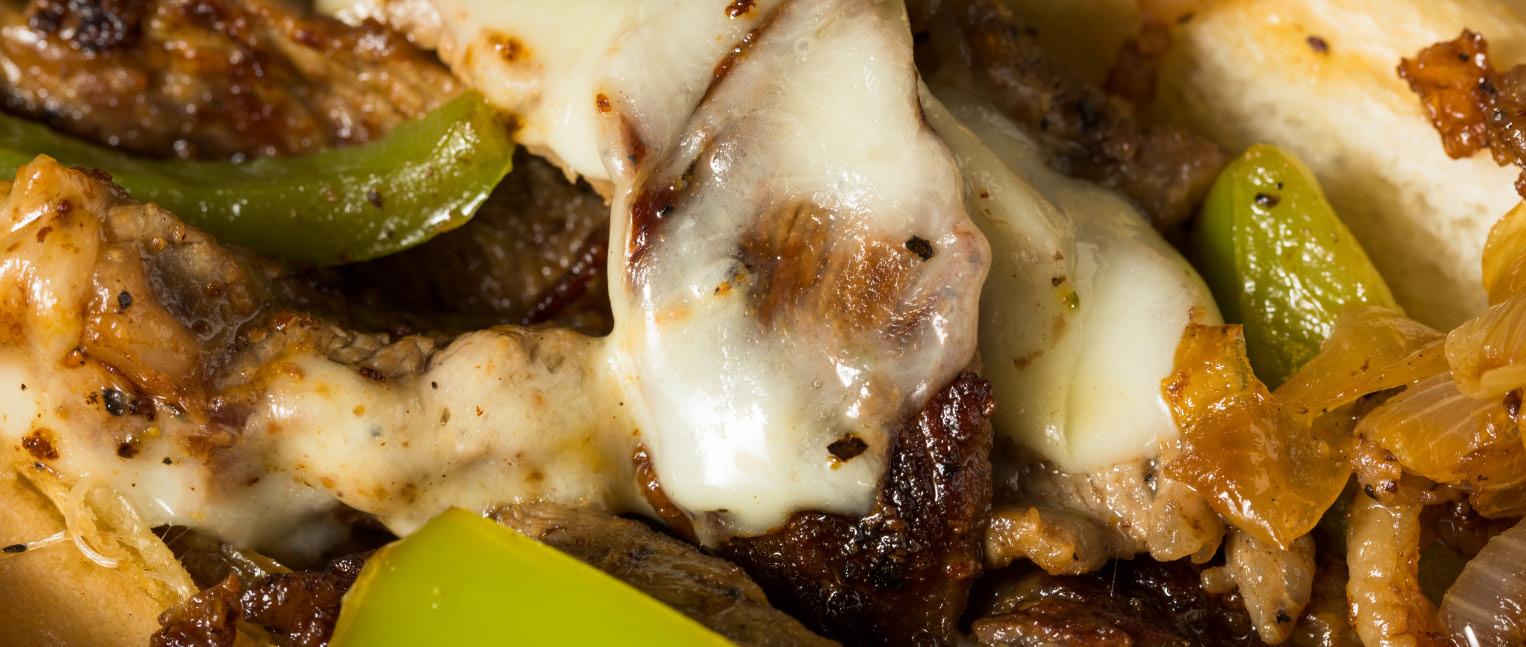
• 1 12 pack sweet rolls
• 1-2 tablespoons olive oil
• 1 large onion thinly sliced
• 1 large green bell pepper thinly sliced
• 1 pound shaved steak
• 2 tablespoons Worcestershire Sauce
• 1 teaspoon Dijon mustard
• 1 teaspoon garlic powder
• 1 teaspoon salt
• ½ teaspoon black pepper
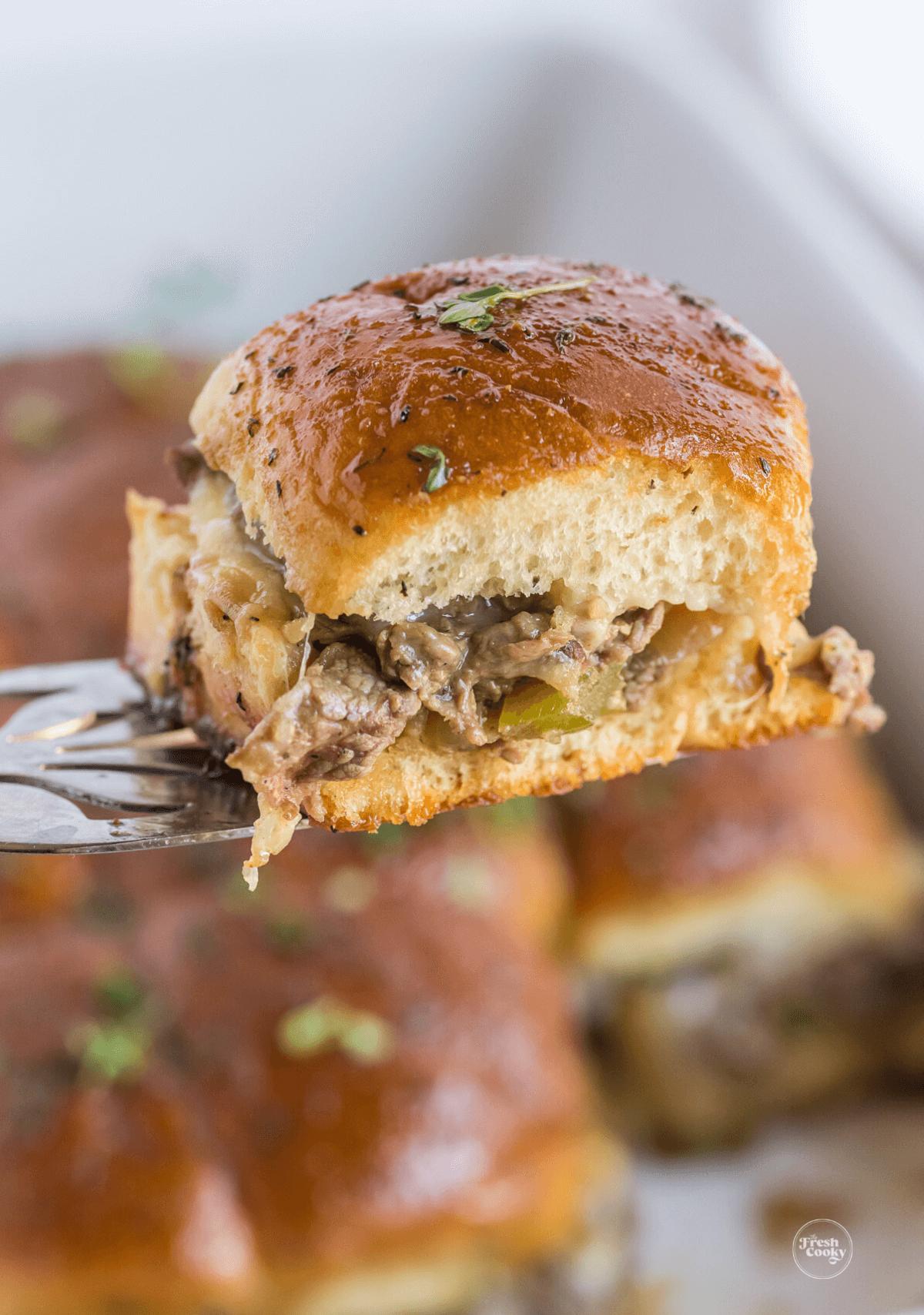
• 6-8 slices provolone cheese Recipe
• 3-4 tablespoons butter, melted
• 2 teaspoons brown sugar
• 1 tablespoon Worcestershire sauce
• 1 teaspoon Dijon mustard
• ¼ teaspoon garlic powder
• ¼ teaspoon onion powder
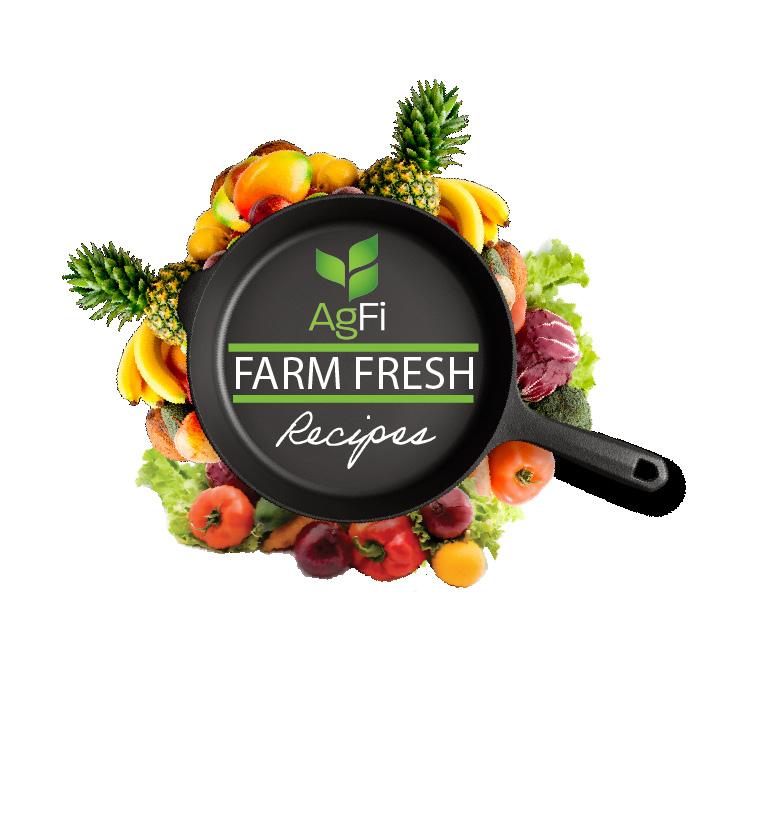
• 1 teaspoon dried thyme leaves or ½ teaspoon fresh chopped thyme
1. Preheat the oven to 350° F. Using the ingredients under Sandwiches, stir together Worcestershire sauce, mustard, garlic powder, salt, and pepper in a small bowl and set aside.
2. In a large skillet, heat oil and add sliced onions and green peppers. Cook, stirring occasionally over medium heat until peppers are soft and onions have caramelized slightly. Remove to a plate.
3. Increase heat to medium-high heat. Add shaved steak and, working quickly, toss to prevent from clumping. Cook until the steak is slightly pink, but mostly browned. Pour in sauce from Step 1, stirring to coat.
4. Add cooked onions and peppers. Stir and remove from heat.
5. Slice rolls in half horizontally and set aside the tops. Place bottom of rolls in greased 9x13 baking dish and spread the meat and onion mixture and then top with cheese and the top half of rolls.
6. In a small bowl mix together topping ingredients and pour over rolls.
7. Cover with foil and place sliders in the oven and bake for 25 minutes. Remove foil and bake additional 7-10 minutes until cheese is melted and sliders are golden. Serve immediately.

California pistachio growers are searching the globe for potential emerging markets to handle anticipated record-shattering crops in the coming years.
Amarket outlook for the surging pistachio sector was offered at the American Pistachio Growers annual conference last week in Monterey.
Pistachio shipments to Europe, Asia, Canada and Mexico allowed the sector to avoid overproduction with a 2023 crop that approached 1.5 billion pounds.
Since pistachios are alternate-bearing—producing a light crop one year and a heavy crop the next— 2024 is considered an “off” year for the crop and will be down slightly from the 2023 figure.
However, in five years, leaders in the pistachio business said they expect annual crop production
to increase to several billion pounds due to the number of nonbearing acres expected to come into production.
Bob Klein, manager of the California Pistachio Research Board, said pistachio acres in California nearly doubled between 1990 and 2000. Since then, he said, “we doubled again each of the next two decades.”
Klein estimated the state has more than 600,000 total acres of pistachios.
“We can’t keep doubling acreage forever,” Klein said. “We have 140,000 acres of nonbearing pistachios that will come on in the next five years.”
While the acreage has expanded, growers have also planted pistachio varieties that are more productive.
Before 2011, the standard variety was Kerman, which produces 3,100 pounds per acre in heavy-bearing years but only 2,200 pounds per acre in light-bearing years. Since 2011, growers have planted the Golden Hills variety, which yields 3,500 pounds per acre in heavy years and only drops to 3,300 pounds an acre in the light years.
“We will have almost 2 billion pounds in 2027,” Klein said. “Over the next five years, we will have 8 billion pounds and we have to move it globally.”
Wesley Wilson, director for member services and communications for American Pistachio Growers, said 72% of state pistachio shipments are exports. Of those, 22% are shipped to Europe, 20% to China, Hong Kong and Vietnam and 15% to customers in the Middle East and Africa.
Domestic shipments declined 1.5% last year, so growers banked on the 197% increase in exports to absorb the record-setting 2023 crop. Shipments to China increased 156% and to Europe by 102% in 2023. China remains a major market for pistachios, but the growth rate of this market is anticipated to slow.
“China is moving from a shift from an agricultural to an industrial economy, to a slower shift to a more modern economy,” said Marci Rossell, an economic forecaster and former co-host of “Squawk Box,” a CNBC cable news program. “China’s population has peaked and has begun a slow decline like Japan in the 1980s. India is the next China.”
The industry began marketing pistachios in India several years ago, and shipments to the country are significant.
“In 2020, we introduced India and shipped over 40 million pounds of pistachios to India last year,” Wilson said. “Their middle class is larger than the entire population of the United States.”
Technology could make the transition to an industrial economy faster and smoother in India, Rossell said.
“There are 790 million cellphone users and a general acceptance of computer technology in India,” Rossell said. “Artificial intelligence will make accounting, computing and consulting services cheaper. It can also make education more efficient.”
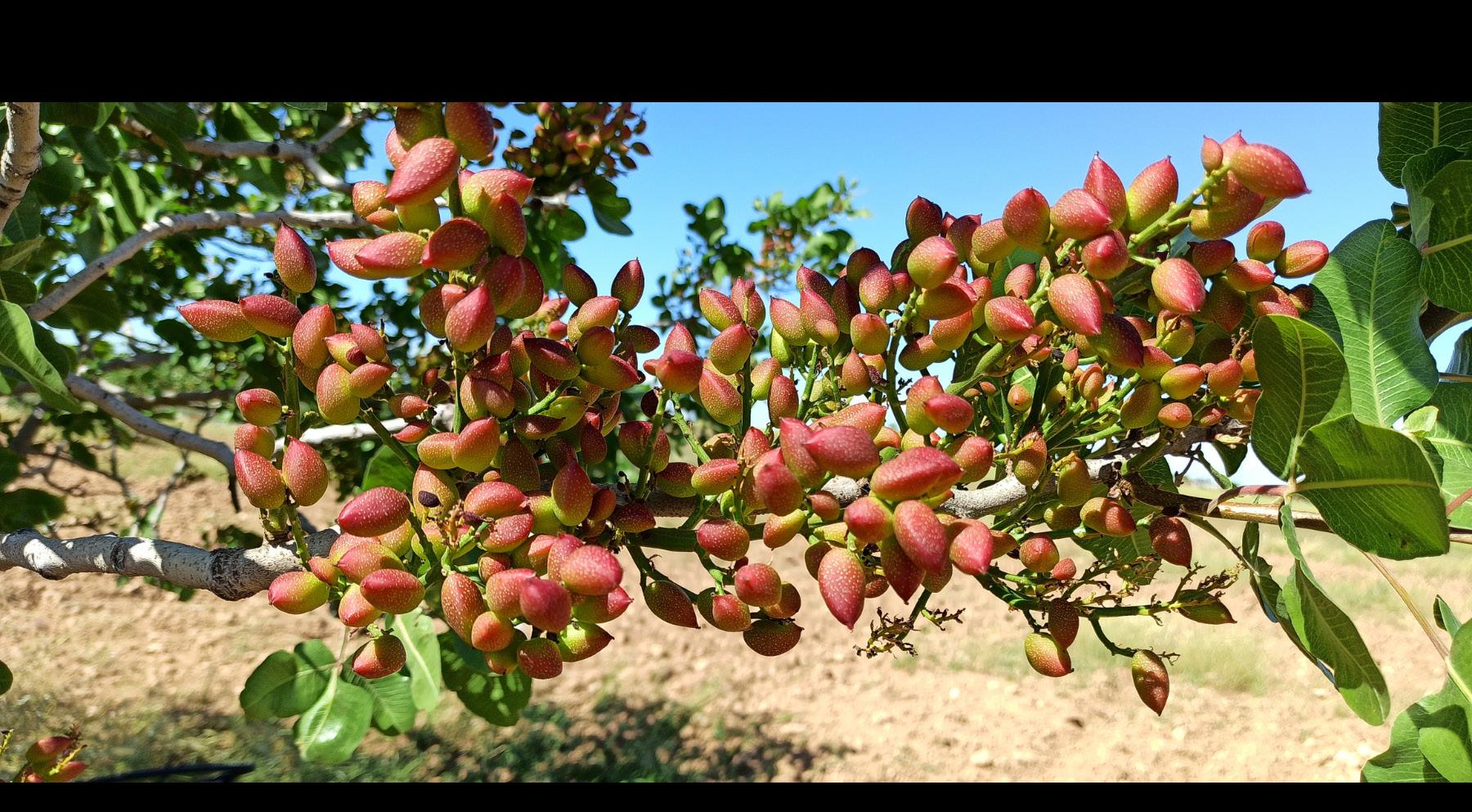

Technological advances such as AI make India a prime marketing target as American Pistachio Growers directs nutrition research money to publicize the health benefits of pistachios with consumers in major current and potential markets.
“We have a lot of experts in the areas we are marketing to,” said Scott Fryer, vice president of global marketing for American Pistachio Growers. “We orient our nutrition research toward consumer trends.”
As the pistachio industry focuses its research on nutrition, it also tries to communicate in ways that resonate with younger-generation customers.
“Older people read newspapers and watch cable television,” said Jimmy Szczepanek, managing director of Ketchum’s Food, Beverage and Cultivate industry group. “TikTok is the No. 1 source of information about food for Generation Z.”
Pistachio leaders sounded confident that they can meet the challenge to expand global markets for larger crops in the future.
“With about 100,000 nonbearing acres, we can and should expect a 2 billion-pound crop within the next seven years,” said Ali Amin, marketing
communications committee chairman for the California Pistachio Export Council.
Amin, founder of Primex International, a trading company dedicated to processing, promoting and exporting pistachios, said council members “will continue to be vigilant and monitor the export markets, while supporting American Pistachio Growers and the industry in increasing demand in existing markets, as well as opening new markets.”
California’s pistachio sector, which had 53,700 bearing acres in 1990, compared to 453,750 in 2023, ranks among the state’s top 10 agricultural commodities, valued at $3 billion.
“Pistachios contribute more to the economy than the total gross domestic product of 51 countries,” Fryer said.
(Bob Johnson is a reporter in Monterey County. He may be contacted at bjohn11135@gmail.com.)
Reprinted with permission for use from the California Farm Bureau Federation.
Pistachio sector seeks markets to absorb bigger future crops. (https://www.agalert.com/californiaag-news/archives/february-6-2024/pistachio-sectorseeks-markets-to-absorb-bigger-future-crops/)
The final stretch of preparations for Plant 24 is a good time to assess factors that affect production and implement new or refined practices that address weak links. Dr. Joel Gruver, Professor of Soil Science and Sustainable Ag at
Western Illinois University,
oversees
research at the University-owned, Allison Organic Farm in western IL.
Recently, Dr. Gruver presented to a crowd of organic farmers at a CGB-hosted meeting in Connersville, IN. During his presentation, Dr. Gruver highlighted the various cropping systems he’s applied through the years and the results they garnered; making a strong case for incorporating a regenerative year for weed control and higher yields.
He says, “The research farm, where I get to do a lot of organic row crop work each year, we grow 65 acres of corn, soybeans, small grains, and some alternative row crops.”
Gruver offered a number of research articles that discuss weed control methods in organic production. There is “Blind cultivation for Early-Season Weed Control in Organic Grains”
that presents the idea of removing weeds by identifying the ‘weak link’ in the growth stage. Gruver notes that the weak link is when they are in the “white stage”. This means the seed has germinated, but it hasn’t reached the surface yet. You can get the most control in this stage with the least effort. Once weeds turn green, they’re much stronger. The white stage can see weed control with a simple rotary hoe or a tine weeder.
Next on his list of resources is, “Reducing Weed Seed Pressure with the False Seedbed Technique.” The concept here - grow the weeds, then the crop.
Dr. Gruver, himself, agrees with the ideas presented in the paper entitled, “Weed the Soil, Not the Crop.” The authors of the publication, Eric and Anne Nordell, explain that many sustainable
growers subscribe to the philosophy of ‘feed the soil, not the plant.’ Their whole farm approach to weed management follows the same line of thinking – only they call it ‘weed the soil, not the crop.’ Instead of relying on the cultivator or the hoe to save the crop from the weeds, they use cultural practices, including cover cropping, bare fallow periods, rotation and shallow tillage to reduce the overall weed pressure in the soil.
The WIU Research Farm has been focusing on better weed control by primarily addressing two factors over the last ten years:
1. Better Tools/Better Use of Tools
• Better seed bed preparation
• Establishment of better crop stands using JD 1760 12-row air planter with RTK guidance
• More intensive blind cultivation (tine weeder and rotary hoe)
• Precision row cultivation equipment for 1st cultivation
• Earlier row cultivation when conditions permit/warrant
2. Better Use of Ecology
• More effective management of cover crops and crop residues
• Inclusion of summer fallow periods (mostly << 1 month)
• Improved understanding of organic NT opportunities
• Improvements in soil structure
• Novel cropping systems
In addition to these factors, Dr. Gruver spoke about reaping the rewards of a regenerative year.
In 2017, they pulled the plug on a no-till soybean field because it was over-run with weeds. There were speculations from neighboring farmers that there were still 25 bushel beans in ground, but they made the hard decision to till them in. The following season, they set a new record for corn yield at 225 bu/a. Gruver noted, “The soil was exceptionally mellow, weed pressure was low, and management was easy!”
What were the factors that made management easy? Could they reproduce the results?
Dr. Gruver offers, “The high corn yields achieved in 2018 resulted from the convergence of multiple factors:
• Corn hybrids with genetic potential for high yield
• Higher than standard population (35.5k vs 31k)
• Earlier than standard planting date (1-2 weeks early)
• Excellent soil tilth
• High nutrient availability despite a low application rate of poultry litter
• Favorable weather conditions
• Good weed control
The high biomass fallow (aka regenerative year) in 2017 directly contributed to three key factors: excellent soil tilth, high nutrient availability and good weed control in 2018 and probably resulted in better net income over two years than if we had taken the soybeans to harvest in 2017.”

Below are two charts that outline the numbers. Scenario 1 shows what they chose to do and the resulting financial benefit. Scenario 2 shows what would have hypothetically happened had they harvested the 25 bu/a beans in 2017 with rough estimates of what production might have looked like the following season.
Gruver emphasizes that if you choose to implement a regenerative year, you need to consider reducing your risk knowing you’re going
to have negative cash flow, followed by an easier, much higher yield year. The research farm has continued this concept with other small grains in succeeding years utilizing various cropping systems and publishing its findings.
You can learn more about the organic research farm and Dr. Gruver’s work by visiting https:// www.wiu.edu/cbt/agriculture/farms/organic/
You can watch Dr. Gruver’s entire presentation by scanning the QR code below.

 SCENARIO 1
SCENARIO 1

• Inflation is still hanging on (3.2% as of 3/12/24 - far from the Federal Reserve’s 2% target) and that is usually bullish for commodities.
• As of late, China has had a rough go economically and the cancellation of roughly 30% of the SRW wheat they bought from the U.S. isn’t a great sign. That said, each week we
review some ‘Macro’ charts and figures to stay in tune with the broader market. Below is the Hang Seng Index (Chinese equities market) in a monthly view stretching back to 2000. Looking at the chart alone, there may be a case for the Chinese equities market to find some footing in the near term. If March closes in the green, this could be something to watch, especially since part of our bearish bias has been on the poor performance of the Chinese economy over the past three years.
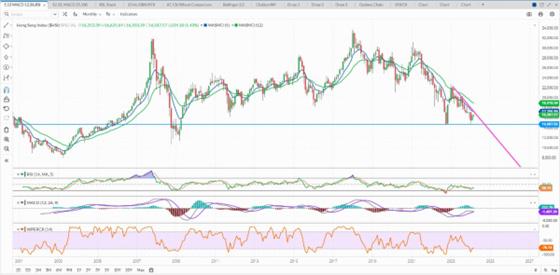
• Of particular interest this year is the impending transition from El Nino to La Nina. Most every forecaster you listen to says it will happen, but there are huge disagreements on how fast the transition will happen. Traditionally, the faster the transition, the higher the chance of hot, dry weather in the heart of the Corn Belt. Right
now, it’s hard to find two summer forecasts that are making the same prediction.
• The chart below shows that last April through June was historically dry and planting progress was not impeded at all. If this spring is anything close to last spring, this will be another bearish factor we will need to deal with.


• This past February through the first half of March is one of the hottest on record and although we have seen some rain events, many places in the Midwest are coming into the spring very dry. Last fall was perfect for putting on fall-applied anhydrous and there
is a lot of fieldwork already accomplished this spring.
• NOAA expects near normal temperatures for the next few weeks, but the pattern may become much more active on rain amounts.
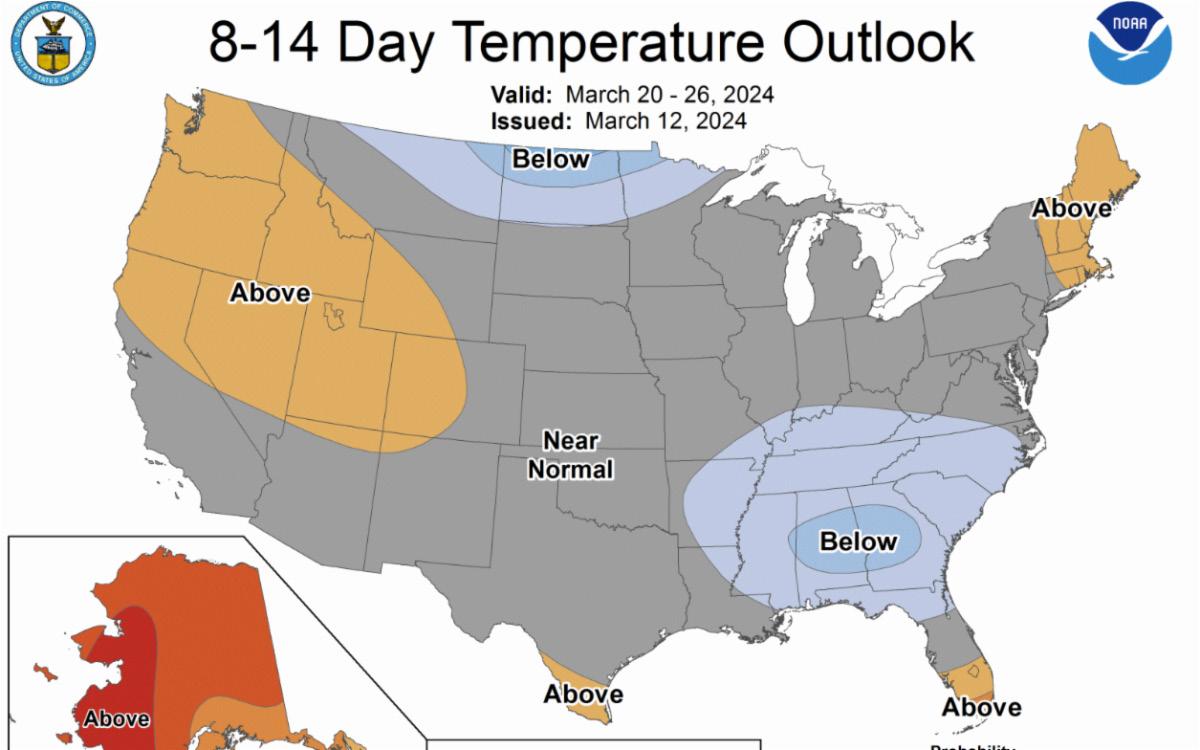
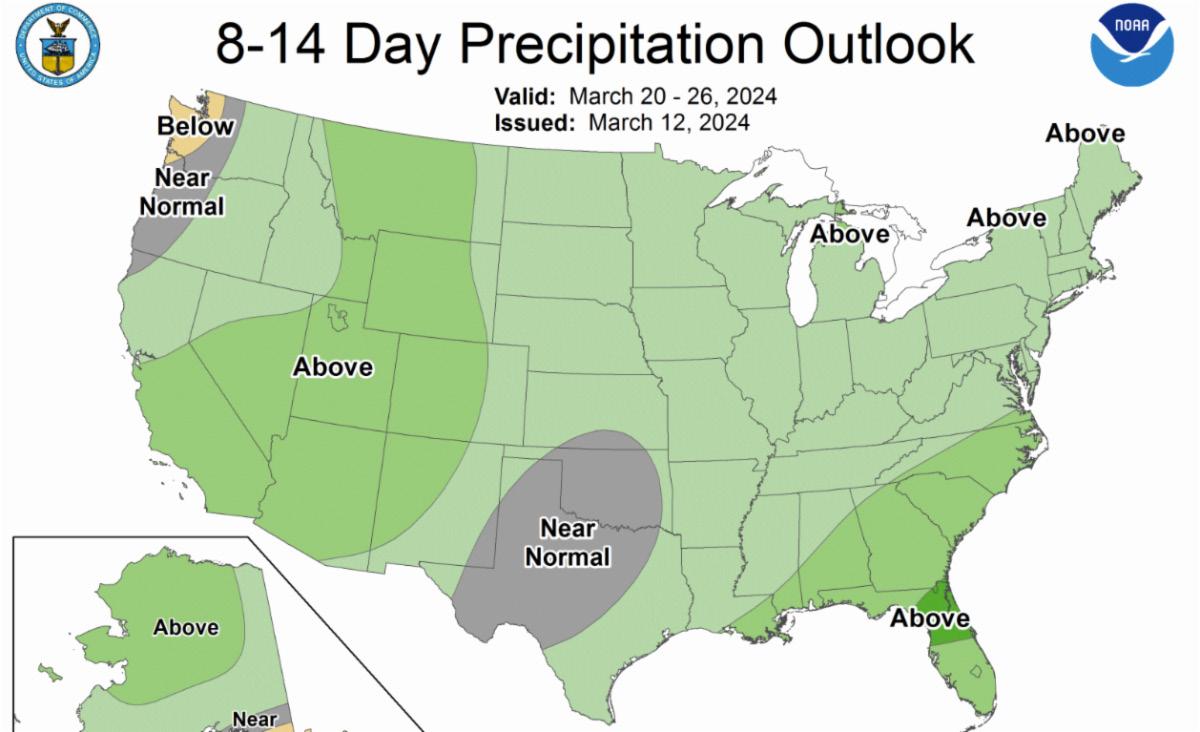
• During the beginning of the Ukraine war, money flowed to commodities and any “new” news there affected our markets. Now, as the conflict is in its second year, it is barely a blip on the radar as far as grains are concerned.
• Russia has continued to flood the world with cheap wheat and Ukraine continues to export grain through the Black Sea. The assumption in the past was that Russia would make Black Sea exports impossible for Ukraine, but in reality, that has not been the case. Russia needs to have the Black Sea ‘open’ to sell its
wheat and raise money to fund its war effort. Russia also has a stake in developing allies. Preventing grains from moving out of Ukraine probably is not in their best interest politically.
• Old and new crop corn have both performed well in March and have recovered nearly 30 from the February lows. Looking at the chart below, will we have enough momentum to continue the move?


• The funds continue to liquidate their record short positions, but farmer selling is increasing on each move higher.
• We continue to feel that setting floors, especially with old crop, is the way to play this out this spring. The fundamentals have not changed and we are still burdened with too much carryout and large farmer-owned supplies. EMMs vs the May and July contracts are the safest play here where you set a floor and hope for more. Talk to your local CGB grain merchandiser for current levels on those contracts.
• We could very well see the market rally into late spring, but please remember that we have a very important report on planted acres on the 28th of March. We can ill afford to see corn acres much more than 91 million. A surprise to the high side will be a heavy burden on new crop corn. If the weather is cooperative and planting goes well, we will need to see a major shift in the summer weather patterns to generate buying interest.
• This is a time to get a plan together and execute when your targets are hit.
• Rarely have we seen such a disparity in the estimates of the crop size in Brazil. CONAB, Brazil’s equivalent of our USDA, is estimating a 146.9 mmt crop. The 2.5 mmt haircut now puts the USDA 8.1 mmt higher than CONAB. (In bushels, the difference is nearly 300 million. That is basically the entire U.S. projected carryout!)
• The USDA in January and March also raised their estimates of last year’s Brazilian crop. They seem to believe that acre expansion in Brazil has been more aggressive than advertised and they are basing their increases on the record exports that have been coming from Brazil for the past 18 months.
• The old crop May contract is now firmly above the 20-day moving average and cash beans are within striking distance of $12.00. This 70-cent rally has increased farmer selling, as it should. With the March 28th acreage report just around the corner, one should, at the very least, consider locking in some $11.70 floors with EMM contracts.
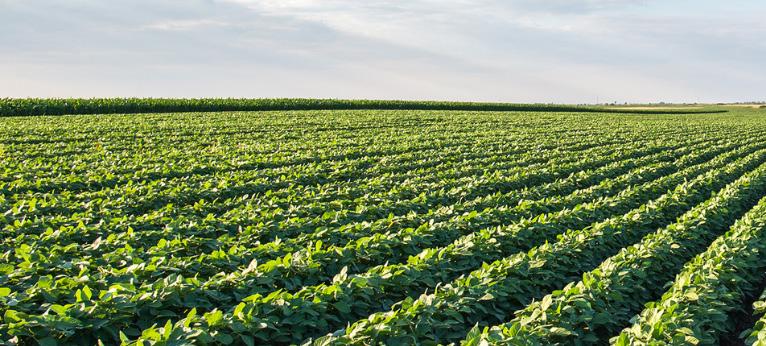
• The U.S. export market for soybeans is living on borrowed time and it is reflected in the river basis markets. When considering interest on $12.00 beans at 7 cents a month, there is little incentive to carry the beans into the summer.
• There have been several articles circulating recently that farmer bankruptcies in Brazil are up 535% in 2023. Serasa Experian, a data service company, said that most of the filings were soybean farmers, but cattle ranchers and coffee growers have also seen notable increases. Although the number of filings is low compared to the number of farmers, the pace of filing from quarter to quarter is alarming. High-interest rates seem to be the main cause.
• Soybeans do not spend much time trading in the $11.00 range. We are much closer to $12 than we have been and the market should be rewarded ahead of the March 28th Prospective Planting Report. Most likely the trade will be reminded once again that acres of soybeans will be increasing with some estimates as high as 3 to 4 million more over 2023. Rewarding this rally now, before the report is good risk management.
• The November futures contract has breached the 50-day moving average as the funds continue to cover some of their record shorts. This calendar year, all of the short rallies that we have seen have been capped at 25 to 30 cents.
With more than 50 years experience in grain handling and transportation, Consolidated Grain & Barge Co. is an industry leader. Every day, CGB’s grain market experts provide special reports and daily commentary on weather and market conditions that affect commodity prices and help producers manage risk. This free report is available daily to your inbox. Scan the QR code to subscribe and connect with a CGB Grain Merchant.


AgriFinancial is a premier agricultural lender, backed by decades of ag expertise and dedicated to understanding your longterm goals in the face of ever-changing markets.
As a subsidiary of CGB Enterprises, Inc. (an innovative and progressive leader in agriculture since 1969), AgFi takes a comprehensive approach to custom-tailored financial solutions.
Our sales officers are strategically located throughout the country to be able to meet customers on their farms, sit at the kitchen table, identify the producer's individual goals, and find the financial solution that works best for each unique operation.

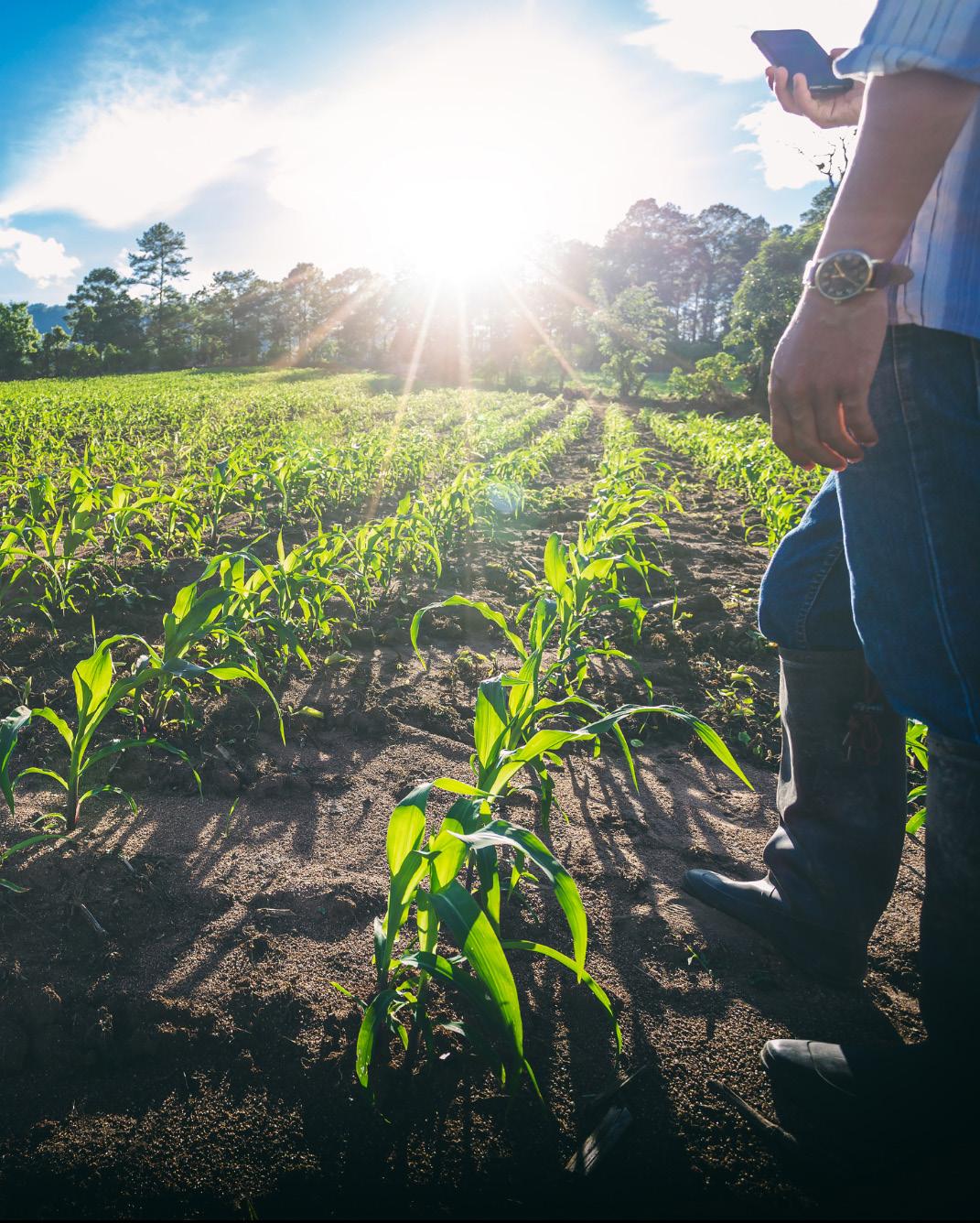

Phone: 877.548.2622
FinanceInfo@cgb.com
www.cgb-agfi.com
Issue No. 10

Seed, Feed and Field is a publication produced by CGB Agri Financial Services, Inc., (“AgriFinancial”). The information and opinions contained herein have been compiled or derived from sources believed to be reliable, but no representation or warranty, express or implied, by AgriFinancial is made as to the accuracy, completeness, timeliness, or correctness of the information, opinions, or the sources from which they were derived. This publication is provided on and with the condition that neither AgriFinancial nor anyone else is, by virtue of this publication or its contents, engaged in rendering investment, legal, accounting, tax, or other professional advice or services. This publication may include “forward-looking statements,” which include projections, forecasts, or expectations of future performance or results, as well as statements or expressions of opinion. No reliance should be placed on any forward-looking statements expressed in this publication. The content of this publication is for general information purposes only and is not to be relied upon or used for any particular purpose. AgriFinancial specifically disclaims any liability for any errors, inaccuracies, or omissions in this publication and for any loss or damage, however arising, that may result from the use of or reliance by any person upon any information or opinions contained herein. Such information and opinions are subject to change at any time without notice, and nothing contained in this publication is intended (nor shall it be construed) as an offer or solicitation with respect to the purchase or sale of any goods, services or securities, including, without limitation, the same by or of AgriFinancial. Seed, Feed and Field features publications, articles and/or reports from others unaffiliated with AgriFinancial, and the views and opinions expressed in these articles or reports do not necessarily reflect those of AgriFinancial. This document may not be reproduced, distributed, or published, in whole or in part, for any purposes, without the prior written consent of AgriFinancial. All copyrights are reserved.